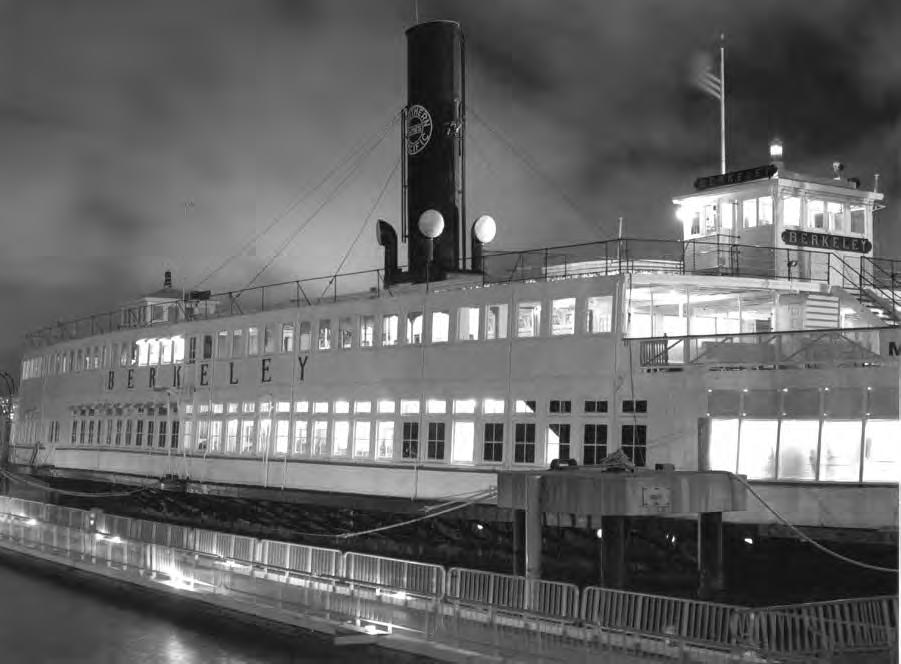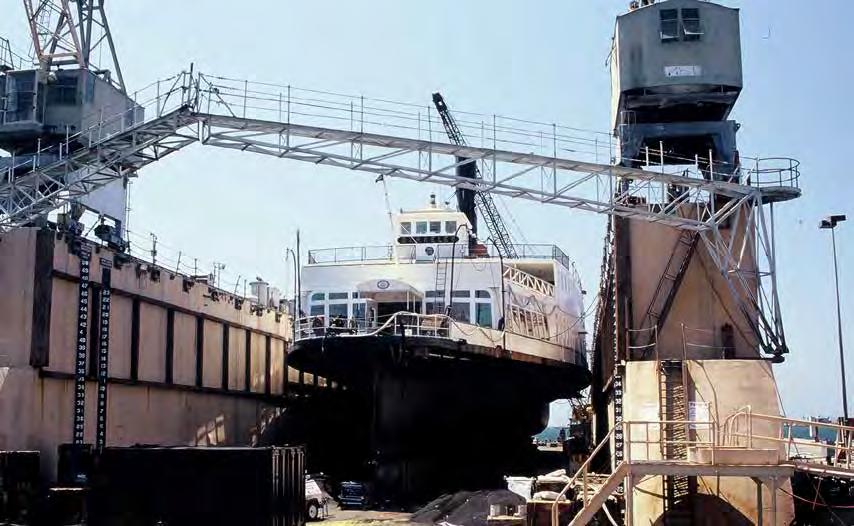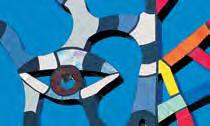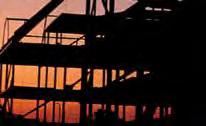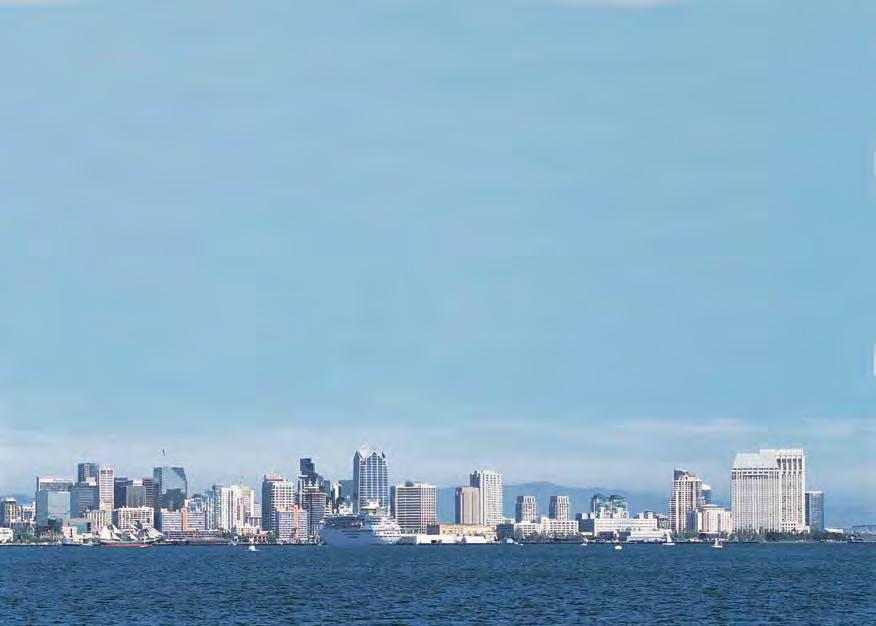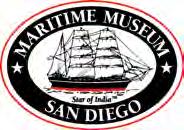M ains ’ l H aul
A Journal of Pacific Maritime History


A Pioneering West Coast Ferryboat



A Pioneering West Coast Ferryboat
2 From Sail to Steam Ray Ashley
4 Union Iron Works
Roberto Landazuri
8 The Dickies
Roberto Landazuri
10 Ferry Steamer BERKELEY
Chuck Bencik
32
The Driving Force
Powell Harrison
40 Mishaps and Tragedies
46
Mellissa Eddy
“There Was No Quick and Easy Way”
Diane Cooper
This publication is a reprint, edited with changes and emendations, of the Fall 1998 Mains’l Haul (34:4).

Subscribe to Mains’l Haul by joining the Maritime Museum of San Diego! Museum members also receive a quarterly newsletter and other benefits. To subscribe, comment, or submit articles to this peer-reviewed quarterly, visit the Mains’l Haul pages at www.sdmaritime.org, email editor@sdmaritime.org, or write to Mains’l Haul, Maritime Museum of San Diego, 1492 N. Harbor Dr., San Diego, CA 92101.
Our mission is to engage members and the public in the study of maritime history, while promoting scholarly research. We welcome submissions on all aspects of the Pacific’s past, and encourage a wide variety of perspectives on this rich heritage. Articles are indexed for researchers worldwide in America: History & Life and Historical Abstracts. ISSN# 1540-3386
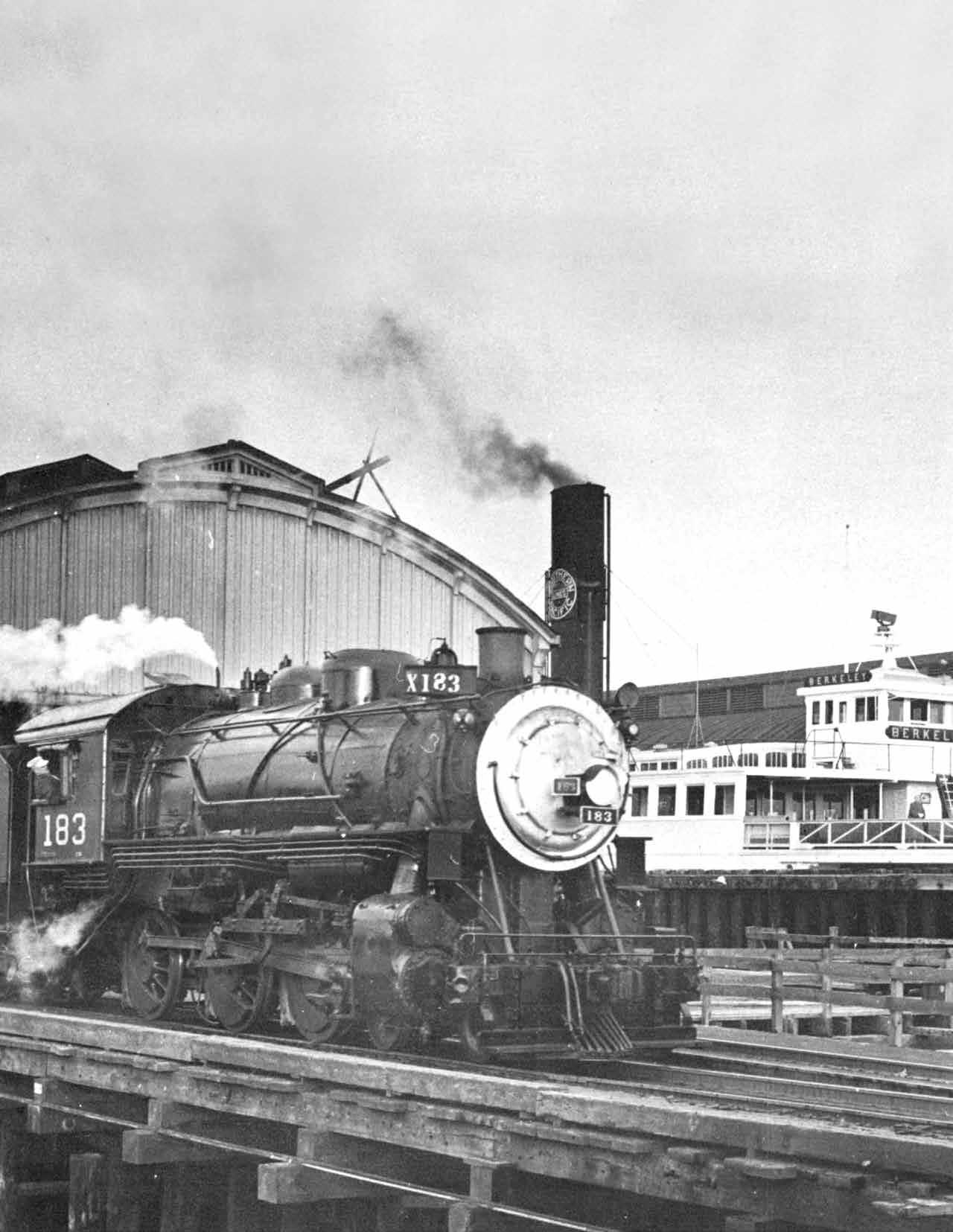
Steam made the world run on time. Sailing vessels could not keep to the precise schedules required by steam trains, but steam ferries like Berkeley could. Here, a Northwestern Pacific engine pauses on the Oakland Mole, as Berkeley waits to cross the Bay in the mid1950s.
At 6:15 on the morning of February 23, 1905, the ferryboat Berkeley was on schedule, about to dock in San Francisco, when out of the fog loomed the schooner Point Arena. This merchant sailing vessel’s captain, according to the wreck report, “was determined to keep his course.” While no harm was done to the hundred commuters aboard Berkeley, other than to their presumably shaken nerves, with hindsight this collision seems symbolic. Around the globe, the world of the sailing ship, which depended on the wind and was thus unable to keep to precise schedules, was colliding with the tightly-scheduled world that steam power made possible. Although the outcome of these two vessels butting against each other on San Francisco Bay seemed inconclusive in 1905, we now know who won: Berkeley and the mechanized, clockoriented world she represented.
between San Francisco Bay and Alaska.
by Ray Ashley Director, Maritime Museum of San Diego
Trading vessels, whalers, fishing vessels, and the occasional warship had created the tenuous skein of communication, immigration, commerce, and political administration that sustained North America’s West Coast as a far distant outpost of the Atlantic-based economic world. The longer and more tenuous such vital seaborne connections became, the more dependent far-flung communities like San Diego and San Francisco became on the technology and the culture of the sailing ship.
Sailing ships depended utterly upon the wind: a source of power greatly variable in its distribution, availability, and intensity. Although the wind-driven oceanic sailing ship created worldwide connections and the first large-scale technological system, the very nature of its primary energy source kept these connections and this system from functioning in a regular and predictable manner. Without the ability to control and manage the velocity, direction, and duration of the wind, sailing ships were unable to provide the world’s economic communities with regular and precisely scheduled interchange. Newspapers carried the tide tables, the only predictable maritime information, on the front page. Ship arrivals were news, ship departures conjectural. Schedules were vague and workdays keyed to the needs of the moment or the season. This was the world for which merchant sailing ships like our own Star of India were created, and the world in which San Diego and San Francisco, products of the sailing ship, established themselves.
That old world ultimately became incongruous with the new one created by the advent of steam mechanization and the gravitation of capital to this new form of energy. In America especially, steamers on rivers and coastal routes, later aided by the railroads, stitched the continent together and created an inward stimulus for immigration, investment and conquest. Even Pax Britannica on the deepwater supremacy of British sea power in the age of sail, came to rely upon a worldwide chain of coaling stations. The demise of the sailing ship and the world it created was not due to inherent inefficiency or intrinsic limitations of size, strength, or speed; it was due to the incompatibility of organically-based economies with mechanized systems. Indeed, into the twentieth century, the sailing ship continued to advance technically even while the world economy unraveled beneath her. Star of India’s history is representative: her life’s long journey took her from globe-girdling merchant ship into ever more marginal niche markets, ending by ferrying fishermen and cannery hands
A quarter of a century before Star of India was launched, the union of railroads and telegraph first linked London to Dover and Paris to Calais. Neither enterprise managed to achieve financial success, however, while they relied upon sailing ships to maintain the short link across the English Channel. When steam ferries, which could run to schedule, replaced those sailing ships, these enterprises began to prosper. Commercial steamship routes linking Panama’s West Coast to California and its East Coast to New Orleans were established by 1847. Again, neither route proved profitable until a railroad connected them across the isthmus in 1855. In the first case a steamship route linked two railroads, in the latter a railroad linked two steamship routes.
Each stitch in the growing mechanized world unraveled the weave of the older economic world, substituting for unreliable wind a largescale system that could arrange the acquisition, transportation, and storage of fossil fuel for consistent and predictable use by ever more integrated machines running ever more precisely to schedule. Within this technologically advancing world, sailing ships, unwilling to concede obsolescence, continued to challenge the steam vessels.
This new world had its own heroic moments and catastrophes, of course, just as the old one had, and you will read about some of them, as they related to the ferry Berkeley, in the following pages: the rise of West Coast shipbuilding; experimentation with new technologies and arrangements of propulsion; the linkage of railroads to steam navigation; the great earthquake and fire of San Francisco; the mishaps of “the pile driver’s friend” and her even more unwieldy predecessor Silver Gate. Of them all, the 1905 collision between the steamer Berkeley and the schooner Point Arena, whose captain “was determined to keep his course,” now appears as a symbolic representation of the worldwide technological struggle between sail and steam, a struggle our museum addresses through the preservation and exhibition of both the sailing bark Star of India and the steam ferry Berkeley.
As the following pages make clear, Berkeley is a noteworthy element of a technological revolution that linked the West Coast to the rest of the world in new ways, a revolution that changed our communities and their relationship to the sea beyond recognition. We now live in the latter days of the mechanized world Berkeley helped create, a world itself being supplanted by a revolution in electronic and communications technology. One natural human reaction to the succession of one way of life by another is nostalgia; for readers of any age, it will be difficult to look at the evocative pictures in this publication without feeling a twinge of loss for the vanished world of the Bay ferries, supplanted by the bridges and automobiles which proved more efficient in delivering their cargoes of people and goods on schedule. One may wish to pause and listen for the faint receding wail of the steam whistles, and consider the regularity and dependability of Berkeley’s great triple expansion engine: the pulsing heartbeat of a maritime world that is slipping away into the fog of memory.

Roberto Landazuri
Thepioneering ferryboat Berkeley, whose screw propellers and triple-expansion engine set her apart from the West Coast’s paddlewheel-driven ferries, was built by a pioneering West Coast shipyard. A true “Forty-niner,” the yard that built and launched Berkeley began in 1849 when the Donahue brothers, James and Peter, opened their smithy.1 Peter, a foundryman, and James, a boilermaker, ran their simple charcoal forge and a pair of hand-operated bellows in a modest structure on the northwest corner of Jackson and Montgomery Streets in San Francisco. Their brother Michael, a molder by trade, joined them and the operation moved to larger quarters at the northeast corner of First and Mission Streets, in an area then known as Happy Valley. Presumably the business union of the three brothers inspired them to christen their business Donahue’s Union Iron & Brass Foundry.
Shortly after their March 1850 move to First and Mission Streets, the Donahues produced the first iron casting in the new state of California. The item, a spring bearing for the

propeller shaft of the steamer John S. McKim, proved an important development for the Donahues as well.2 At fifty cents a pound, the Donahues turned a good profit on the two-hundred-pound pillar blocks, but more importantly, this job represented the company’s first foray into maritime production.3
A few years later, James and Michael sold out to Peter, who became the sole owner.4 Under his leadership, the company made millions in the early 1850s manufacturing steam engines, saw mills, threshing machines, grist mills, gearing, malt rollers, and other kinds of mill equipment. The company also advertised its production of castings, iron fronts and columns for stores, railings for balconies and stairs, door and window sills, and staircases. Ever the visionary, Peter Donahue began a thirty-three-year association with the San Francisco Gas Works in 1852 when he played an instrumental role in the incorporation of this utility, which brought the first gas streetlights to San Francisco in 1854.5
In June 1856 Donahue constructed a large brick building at First and Mission Streets, and shortened the company’s name to Union Iron Works, Peter Donahue,
Proprietor. The company achieved another important landmark when it designed and constructed the machinery for the sidewheel steamer Saginaw, 6 the first U.S. Navy steam vessel built on the West Coast, which was completed at Mare Island in 1859.7 Five years later Union Iron Works assembled the second naval vessel constructed on the Pacific Coast, the Civil War monitor Camanche 8
Donahue also became involved in transportation ventures such as the Omnibus Street Railroad9 and the fifty-mile San Francisco and San Jose Railroad,10 for which tracks would eventually be built around Mission Bay southward through the Mission District. Finding himself spread too thinly across so many undertakings, Peter Donahue sold two-thirds interest in Union Iron Works to Henry J. Booth, formerly of the Marysville Foundry, and local businessman Charles S. Higgins. From 1863 to 1865 the company operated as Donahue, Booth & Co., adding to its products the manufacture of locomotives, including the “California,” the first locomotive built on the West Coast. The company would build a total of seventeen locomotives.
Perhaps most significant for the shipyard’s future was the appointment of Irving M. Scott as general manager.11 James Dickie, who worked under him when Berkeley was built, recalled that “as an organizer and leader of men,” Scott had few equals:
He chose his men with care and kept a watchful eye on the business, giving praise where it was earned and blame where needed. He worked early and late, did not trust to a time clock, but was there himself at 7 A.M. to look into the faces of the foremen to see if their eyes were clear and their breath odorless.12
When despite Scott’s efforts Donahue, Booth & Co. failed to flourish, Peter Donahue and Charles Higgins sold their interest in the company to a partnership comprised of Henry Booth, George W. Prescott, and Irving Scott. For the next ten years, H. J. Booth & Co. promoted their production of
locomotives, marine and stationary boilers, flue, tubular, Cornish and marine boilers, hoisting machines, pumps and pumping machinery, quartz mills, concentrators, stamps, mortars, hydraulic machinery and distributors, screens, Blake quartz crushers, pattern making, oil machinery, as well as plans and specifications for mill work furnished free of cost.13
When Henry J. Booth retired in June of 1875, the company changed its name to Prescott, Scott & Co. Its focus now shifted to the profitable construction of machinery for the Alaska-Treadwell mines, Alaska’s first large-scale gold mining operation, and large hoisting and pumping plants for Nevada’s Comstock Lode.14 During the Comstock Bonanza of the 1860s and 1870s the works produced an estimated ninety percent of all the mining machinery used in Nevada. It also built machinery for gas works, power stations, water turbines, cable car railroads, beet sugar plants, and for roasting and smelting ores.15
In 1880 a crucial event changed the firm’s future. General Manager Irving Scott took an extended trip around the world to visit shipyards, and on his return decided to reorganize the company with steel shipbuilding as its principal business.16 In 1883 Prescott, Scott & Co. incorporated under its earlier
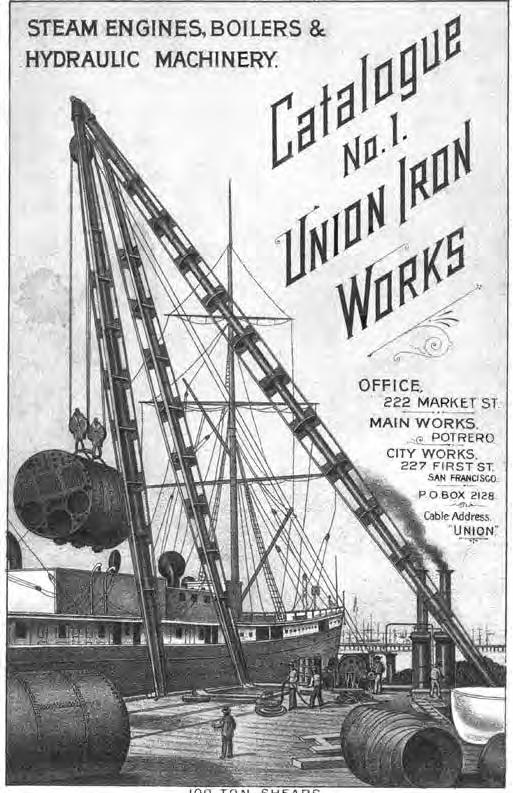
left, Berkeley awaits launching at Union Iron Works on October 18, 1898, as an onlooker climbs the fence for a closer look. The 1892 cover above from the company’s first catalogue depicts the installation of a Scotch boiler with three furnaces, similar to, though smaller than, those installed on Berkeley. The workmen below were photographed at the shipyard two years later.
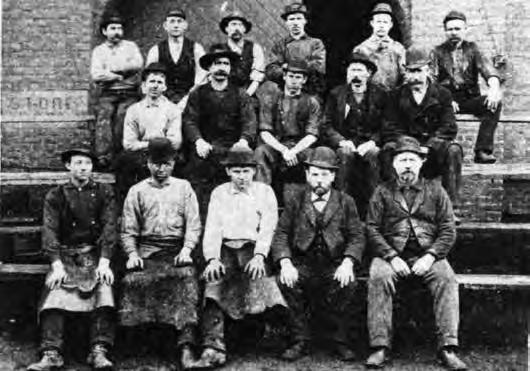
Berkeley
1898 Southern Pacific Railroad passenger ferry. First complete ferry built by Union Iron Works. (The firm had previously designed ferryboat Silver Gate, and designed and built her engines in 1887 for San Diego & Coronado Ferry System.)
San PaBlo
1899 Atchison, Topeka & Santa Fe Railroad passenger ferry. Sold for scrap in 1937. Her hull became a fish reduction plant on San Pablo Bay.
TamalPaiS
1900 Northwestern Pacific passenger ferry. Burned for scrap in 1947.
San Pedro
1910 Santa Fe Railroad passenger ferry. Renamed Treasure Island when she joined Key System in 1938.
naPa Valley
1910 Monticello Steamship Co. passenger ferry. In 1927 Golden Gate Ferries acquired this company and then, two years later, merged with Southern Pacific. Ferry purchased by Puget Sound Navigation Co. in 1942 and renamed Malahat. Towed to Portland in 1956 and burned for scrap.
San maTeo
1921 Six-Minute Ferry Co. auto ferry. This short-lived ferry company operated from 1919 to 1922 on the Carquinez Strait between Vallejo and Crockett. Some plans identified this company as “Rolph Navigation Co.” since the firm’s chief funding source was James “Sunny Jim” Rolph, five-term mayor of San Francisco (1912-1930) and later California governor. Six-Minute Ferry began construction but never took possession, since she was still on the ways when Southern Pacific acquired the company. Served on Puget Sound 1940-1969, and awaits restoration in British Columbia.
ShaSTa
1922 Six-Minute Ferry Co. auto ferry. Acquired by Southern Pacific while under construction. Went to Puget Sound in 1940, later moved to Willamette River in Portland, and converted into a restaurant, which closed in 1995.
yoSemiTe
1922 Six-Minute Ferry Co. auto ferry. Acquired by Southern Pacific while under construction. Went to Rio de la Plata, Argentina, in 1939 and renamed Argentina.
el PaSo
1924 Richmond-San Francisco Transportation Co. auto ferry. Retired 1956.
new orleanS
1924 Richmond-San Francisco Transportation Co. auto ferry. Renamed Russian River in 1938. Retired 1956.
klamaTh
1924 Richmond-San Francisco Transportation Co. auto ferry. Retired 1956. The San Francisco design firm of Walter Landor & Associates acquired and berthed her at Pier 5. Rebuilt in 1964, she served as Landor’s corporate headquarters from 1968 until 1986, when sold to Dura-Flame Corp., who moved her up the Delta to Stockton.
FreSno
1926 Southern Pacific auto ferry. Went to Puget Sound as Willapa in 1937; stripped down to hull in San Francisco Bay in 2003.
STockTon
1926 Southern Pacific auto ferry. Has served on Puget Sound as Klickitat since 1937.
mendocino
1927 Southern Pacific auto ferry. Went to Puget Sound as Nisqually in 1937, is now mothballed and awaiting sale.
LAUNCH OF THE BERKELEY.
name of Union Iron Works, purchased thirty-two acres of land in the Potrero District, about two and a half miles from their First and Mission Street headquarters, and constructed a shipbuilding complex.
In 1892, the state-of-the-art plant at Twentieth and Illinois Streets was described as the most complete West Coast steel and iron shipyard, equal to any yard in the United States or Europe. The new yard included a hydraulic lift drydock (invented by George W. Dickie), three-hundred-ton and six-hundred-ton hydraulic flange presses, electric and hydraulic traveling cranes, and numerous other hydraulic tools, mills, generators and motors.17 Irving Scott ran the plant while the brothers George and James Dickie oversaw shipbuilding operations as superintendent and manager. Thanks to its major expansion program, Union Iron Works was equipped to manufacture in its own plant everything that heretofore had been purchased from vendors outside the region.
In 1887 Union Iron Works designed and built the engine for San Diego’s ferryboat Silver Gate, the first propellerdriven ferry on the Pacific Coast. Unfortunately, she proved so difficult to handle that she was removed from service shortly after her launch.18 A decade later, the company designed and built tbeir first complete ferryboat, the Berkeley, the first successful propeller-driven ferryboat on the Pacific Coast. In the years that followed, Union Iron Works constructed fourteen other steel-hulled ferries, more than any other shipyard on the Bay.
During the firm’s “glory days” in the last two decades of the nineteenth century, Union Iron Works built seventy-five naval and commercial vessels, among them the historic cruiser Olympia and battleship Oregon, both of which gained fame in naval battles during the SpanishAmerican War.19 Shortly after the turn of the century, the company underwent a series of ownership changes, culminating in a hostile takeover by Bethlehem Steel of New Jersey in 1905
While the historic shipyard that built the Berkeley is no more, one legacy has remained. When Bethlehem Steel turned the shipyard over to New York’s Todd Shipyards in 1982, Union Iron Works’ marine architectural drawings and company records were donated to San Francisco Maritime National Historical Park.20 Berkeley and nearly all the vessels built by Union Iron Works are represented in this collection, which showcases a vital part of West Coast maritime history.
1 On Peter Donahue’s early activities in California, see George Harlan and Clement Fisher, Jr., Of Walking Beams and Paddle Wheels: A Chronicle of San Francisco Ferryboats (San Francisco: Bay Books, 1951), 76-109.
2 Built in New Jersey in 1844, the 242-ton John S. McKim was the first commercial vessel built in the U.S. having a propeller drive. Merchant Steam Vessels of the United States, 17901868 (New York: Steamship Historical Society of America, 1975), 115.
3 “History of the San Francisco Yard, Bethlehem Steel Company, Shipbuilding Division,” The Argonaut, 29 August 1947, 10.
4 James died at 38 in 1862. Michael moved to Davenport, Iowa, where he served three terms as mayor.
5 Charles Coleman, PG&E of California: The Centennial Story of Pacific Gas and Electric 1852-1952. San Francisco Gas Works, precursor to Pacific Gas & Electric, was largely financed by Union Iron Works’ early profits. The three brothers were among the original 11 stockholders. From 1855 until his death in 1862 James Donahue served as its president. Peter also served as president 1866-1867 and again 1870-1883.
6 On 16 September 1858 Mare Island Navy Yard laid the keel of the first naval vessel built on the Pacific Coast. Launched as the Touncey on 3 March 1859, she was renamed the Saginaw prior to commissioning on 5 January 1860. In 1870, en route to San Francisco, the ship detoured to Ocean Island in search of shipwreck survivors. Nearing this rarely visited island, she struck a reef and grounded. Her crew transferred much of her gear and provisions to the island before the surf battered the ship to pieces. The Saginaw’s executive officer, Lt. John G. Talbot, sailed with five men in a small boat for Honolulu seeking help. 31 days and 1,500 miles later, their boat capsized in breakers off Kauai. Coxswain William Hanford, the only survivor, managed to secure aid for his marooned Saginaw shipmates. Dictionary of American Naval Fighting Ships vol. VI (Washington, D.C.: Government Printing Office, 1976), 230.
7 Capt. David G. Farragut, who became the Navy’s first admiral, established Mare Island Navy Yard in 1854 on San Francisco Bay and served as its first commandant. In a 19 May 1858 letter to the Secretary of the Navy, Farragut wrote that “it would have been my proudest feeling to build a ship of war of the native woods . . . I hope it will be done by some other commandant.” Four months after his departure, Mare Island received orders to build a four-gun, steam-driven, 453-ton wooden sidewheel gunboat. During the next 140 years, Mare Island built over 500 naval vessels. On 31 March 1996 the Navy closed the shipyard and began turning the site over to the city of Vallejo. Sue Lemmon and E. D. Wichels, Sidewheelers to Nuclear Power: A Pictorial Essay Covering 123 Years At the Mare Island Naval Shipyard (Annapolis: Leeward Publications, 1977).
8 The Camanche was associated with several odd Pacific Coast “firsts.” Built in 1863 by Donahue, Ryan & Secor & Co. of Jersey City, she was dismantled and shipped around Cape Horn aboard the Aquila, which sank at the dock in San Francisco in November, 1863. When she was raised, reassembled, and re-launched a year later, she thus became the first monitor built on the Pacific Coast, the first of that vessel type to sink (albeit in unassembled form!), and, subsequently, the first Pacific Coast-built monitor salvaged.
9 The Omnibus Street Railroad, the first street railroad on the Pacific Coast, opened in October 1862 using horse-drawn equipment.
10 In addition to Donahue’s business involvement, Union Iron Works manufactured equipment for this company. The railway, which later extended its service as far as Gilroy, California, was eventually sold for $3.25 million and absorbed into the Southern Pacific Railroad system.
11 “Irving M. Scott,” Overland Monthly XXVII (May 1896): 4. Scott, born near Baltimore in 1837, came to California in 1860 and almost immediately went to work for Peter Donahue as draftsman. Three years later he became superintendent of drafting at the Miners’ Foundry. Scott’s conviction that the Comstock Lode would continue to provide major revenues for ironworks was the main reason he sought the position at Miners’ Foundry. It also may have motivated Donahue, Booth & Co. to bring him back as manager within the year. His brother, Henry Scott, also worked in San Francisco’s foundries and eventually was president of Union Iron Works. See Irving and Henry Scott entries in James D. Hart, A Companion to California (New York: Oxford University Press, 1978).
12 James Dickie, draft of rebuttal to article “A Shortsighted Policy,” San Francisco Call, June 1907, David W. Dickie Coll., HDC 128, San Francisco Maritime National Historical Park.
13 Hugo P. Frear, “History of Bethlehem’s San Francisco Yard, Formerly the Union Iron Works,” Historical Transactions 1893-1943 (New York: Society of Naval Architects and Marine Engineers, 1945).
14 The Alaska-Treadwell Gold Mining Co., a conglomerate of four mines located opposite Juneau on Douglas Island, was one of the most productive in Alaska. The Chicago Record’s Book for Gold Seekers (Chicago: Monarch Book Company, 1897).
15 A Century of Progress 1849-1949: San Francisco Yard. (San Francisco: Bethlehem Steel Company Shipbuilding Division, 1949), 9.
16 On 28 December 1886, Union Iron Works received its first building contract for a naval vessel, the Charleston. According to the 1893 Merchant Vessels of the United States, she was built between 1886 and 1889, was 300’ long by 45’ wide with an 18’6” draft, and displaced 3,730 tons. Her indicated horsepower was 6,493 and she made 18 knots. Ruth Teiser, “The Charleston: An Industrial Milestone,” California Historical Society Quarterly XXV (March 1946): 39-53.
17 For a detailed description of Union Iron Works’ shipyard, see Master Hands in the Affairs of the Pacific Coast: Historical, Biographical and Descriptive (San Francisco: Western Historical & Publishing Co., 1892), 262.
18 Although Union Iron Works designed the Silver Gate and her engine, they built only her engine. A San Diego builder constructed the ferry and increased her size and weight by lengthening her and building a second deck. Unfortunately, the engine was built to the ferry’s original specifications and was not powerful enough to adequately run her. The propeller technology also made her difficult to handle. These problems led to her failure.
19 Among historic vessels built by Union Iron Works were the first steel merchant ship built on the Pacific Coast, the collier Arago, the cruiser Olympia and battleships Oregon, Wisconsin, Ohio, and California, destroyers Farragut, Paul Jones, Perry and Preble, gunboats Wheeling and Marietta, monitors Camanche, Monterey, and Wyoming, experimental vessels like twoman submarines Grampus and Pike, early tankers George Loomis and Whittier, and ships for Japanese and Russian navies.
20 A Century of Progress, 15, and Michael Lang, “Historical Notes, Bethlehem Steel Shipbuilding Collection, P82-12A,” HDC 345, Bethlehem Steel Collection, San Francisco Maritime National Historical Park.
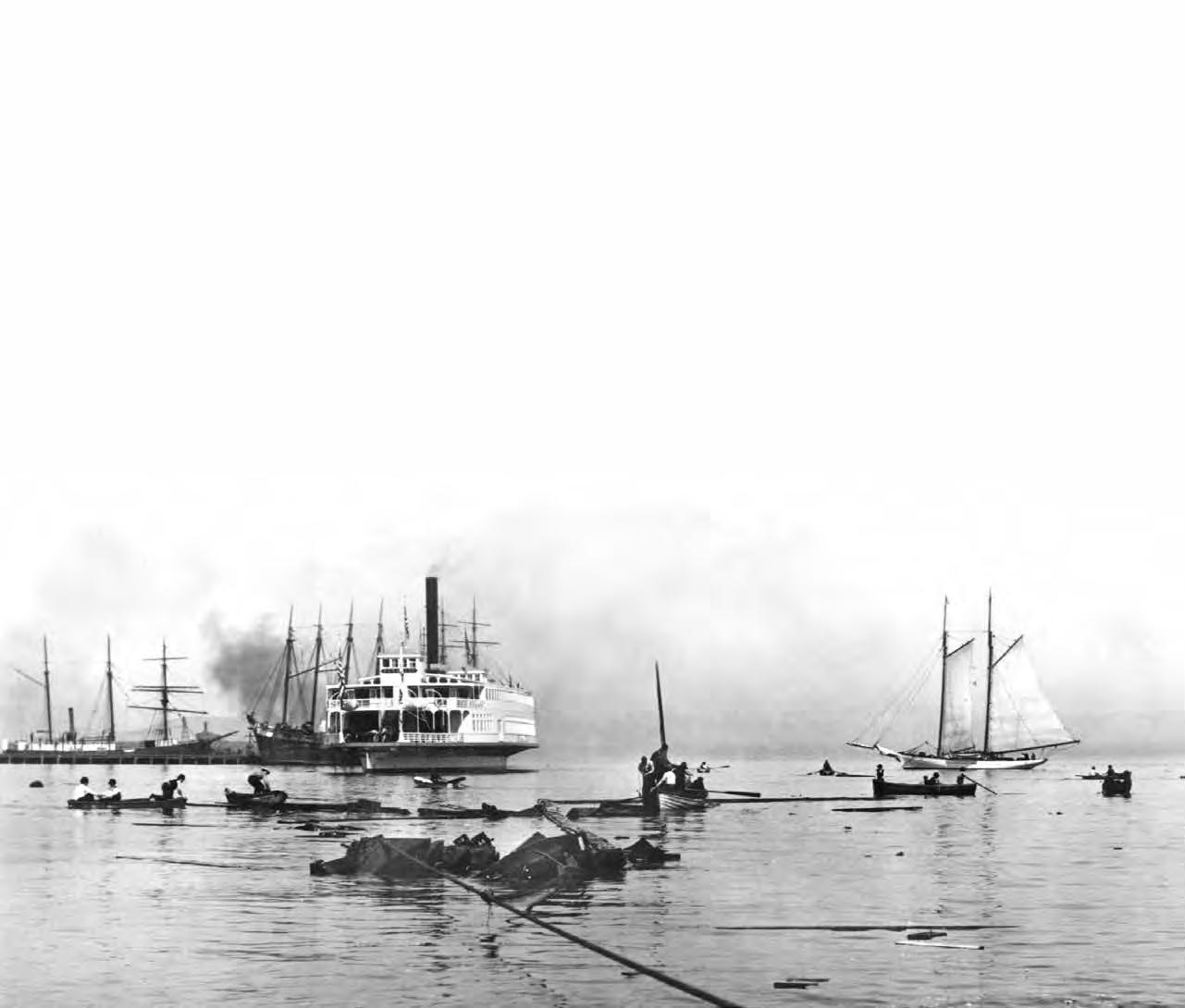
Workmen clear her launch cradle from the water as Berkeley floats free for the first time. At top left, the distinguished maritime artist W. A. Coulter sketched Berkeley on launching day—thought the smoke from her funnel is “artistic license,” since her boilers were not yet lit.
MMSD P6763
Roberto Landazuri
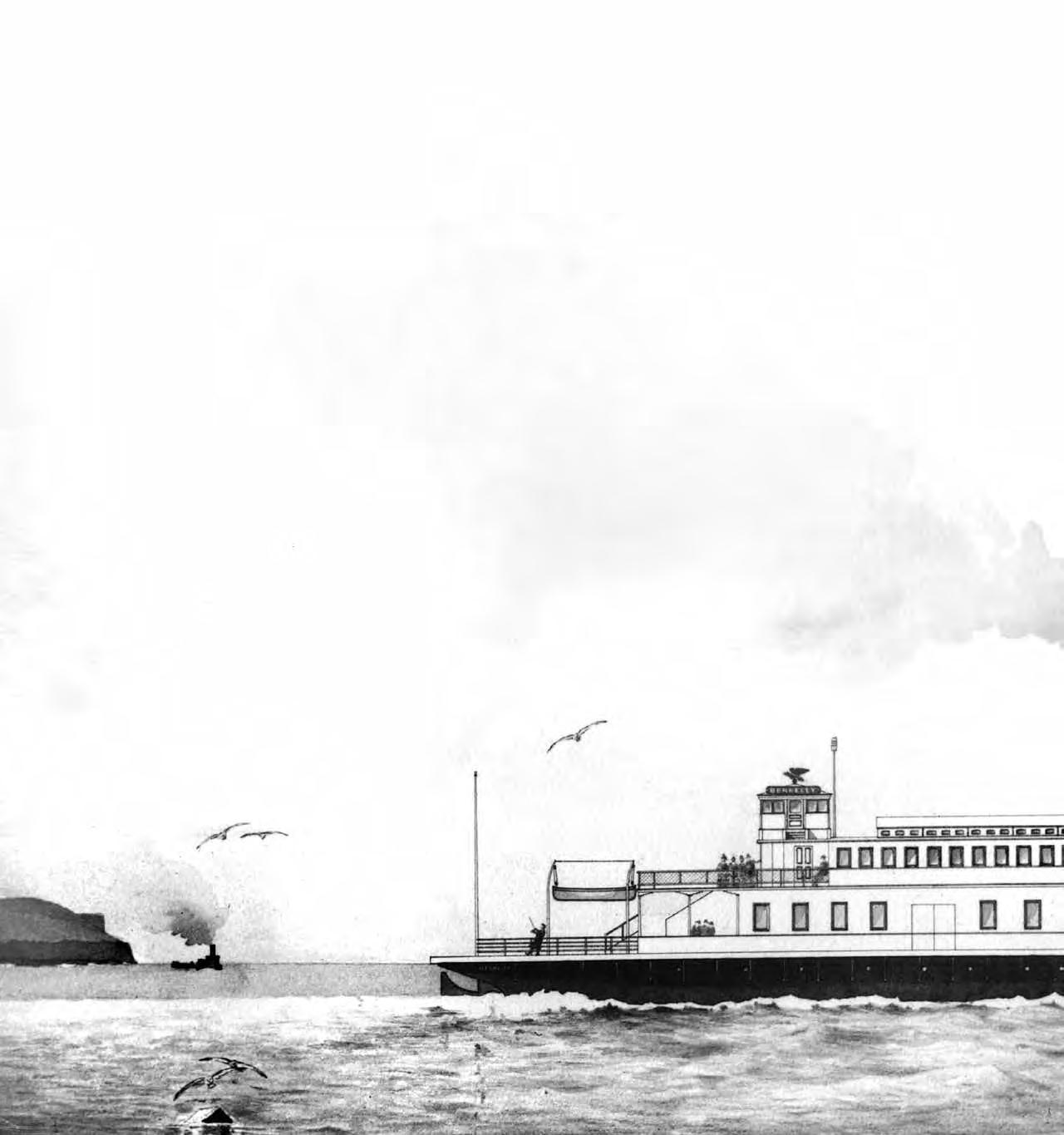
Besides her importance as the West Coast’s first successful propellerpowered ferry and one of the world’s most magnificent surviving Victorian ferryboats, Berkeley is also unusual in that her creation was truly a family affair. Three generations of the Dickie family, emigrants from Scotland who became important West Coast shipbuilders, worked side-by-side in constructing the ferry in San Francisco.
The Editor
The three Dickie brothers were born and raised in Scotland, where the Dickie family had been shipbuilders for several generations. John, George, and James Dickie learned shipbuilding and marine engineering at their father William’s yard at Tayport. 1 In 1869, having decided to emigrate to the United States, George studied a map of the Pacific coast and determined that San Francisco Bay would be the ideal site for a shipbuilding business. Following a brief stint at the San Francisco Gas Works, he went to work for the Risdon Iron Works of San Francisco where, among other activities, he designed machinery for the mines of the Comstock Lode. After selling the shipyard in Scotland, brothers James and John, and their parents, followed George to San Francisco, where, James’ son David recalled, they “had a hard time to get a start.”2 In 1871, the family began a wooden shipbuilding

and repair business in the bayside southeastern section of San Francisco, under the name Dickie Brothers.3
There, David Dickie wrote, his father James “made a study of the strength, fracturing and fastening of Douglas fir and found that it was a much better building material that any of the well-known woods on account of the availability of long lengths.” His experiments demonstrated the practicality of these softer coastal woods for ship construction.4
“The Dickies are all ship builders,” wrote a visitor to their shipyard in 1881, who was surprised to meet seventy-five-year-old paterfamilias William Dickie, “an active man yet,” plying his trade in the yard. “I found him with his coat off, working a bolt cutter.” The visitor noted that his “sons are not educated men, but they are very clear headed and intelligent,” opining that they “are excellent calculators,” though “their methods are not always those of the books.” 5 The Dickies built between twenty-eight and forty steam and sail vessels before the business went into receivership in 1883, due to the Mexican government’s non-payment of the balance due on a contract to build a new hull for the gunboat Democrata. The brothers were unable to pursue their claim against the Mexican government because they had not yet become naturalized citizens.
MMSD P12576 and P12577; both courtesy San Francisco Maritime NHP; above, 14,141n; at right, Bethlehem Steel Coll. P83-142a 1,455
The demise of their business must have been galling to the Dickies, coming as it did during a Pacific coast shipbuilding boom that had begun in 1881, during which the company had built at least fifteen vessels.
Just as his brothers’ independent shipyard venture was coming to an end in 1883, George W. Dickie left Risdon Iron Works to accept a position next door as manager of the new Union Iron Works plant at 20th and Illinois Streets. Now that the Dickies’ shipyard had folded, Union Iron Works chief Irving M. Scott subsequently hired James as well, appointing him superintendent of the new plant, and the company’s golden era of steel shipbuilding began. 6 Both brothers would hold their positions there for over twenty years.
Three generations of the family put their brains and elbow grease into building Berkeley. Their father William came to work for George and James at Union Iron Works as a draftsman in 1895, apparently until his death in 1903. John Dickie’s son David apprenticed there beginning in 1894, and George’s son James S. Dickie was a Union Iron Works machinist between 1898 and 1903. His brother Alexander was an electrician there between 1889 and 1903, and likely helped construct Berkeley, the Bay’s first ferry designed with electric lights. All told, six members of the Dickie family were employed by the shipyard when Berkeley was launched. 7
The eldest of the three brothers, John, did not follow his brothers into Union Iron Works, but but stayed in shipbuilding. Following the 1883 loss of the Dickie Brothers shipyard, John went to work as superintendent of Fulton Iron Works, on the north side of San Francisco. Sometime between 1899 and 1901 he opened a shipyard in Alameda with his son, David, who had served his apprenticeship at Union Iron Works. John W. Dickie & Son specialized in building ferries, including San Diego’s little 1903 ferryboat Ramona. After the earthquake and fire of 1906, they left the Bay Area and reestablished their shipyard at Raymond, Washington, which lasted until 1913. 8
Union Iron Works Superintendent James Dickie retired at age
fifty-seven, and his sixty-one-year-old older brother George followed; in 1907 they formed the San Francisco firm of G. W. & James Dickie, Naval Architects and Marine Engineers. Two years later, George went into business for himself as a consulting engineer and naval architect, while James pursued the same path with his sons’ firm, D. W. & R. Z. Dickie, Naval Architects and Marine Engineers, also located in San Francisco.
All the Dickies had long, active careers as West Coast shipbuilders. The three brothers themselves, who had gone into partnership as new immigrants in 1871, lived well into the twentieth century and into their eighth decades.

1 John was born in 1842, George W. on 17 July 1844, and James on 12 March 1847.
2 Unsigned letter on D. W. & R. Z. Dickie letterhead to Frank B. Kellogg, 26 April 1926. David W. Dickie Records 1882-87, 1898-1957, HDC 128, J. Porter Shaw Library, San Francisco Maritime National Historic Park (hereafter SFMNHP).
3 The business was located on the east side of Illinois St., between Santa Clara and Center Streets.
4 David W. Dickie, “The Pacific Coast Steam Schooner” (n.d., circa 1930), Historical Transactions 1893-1943 (New York: Society of Naval Architects and Marine Engineers, 1945), 40-42, 47.
5 Henry Hall, “Ship Building in the United States,” MS ca.1881, Penobscot Marine Museum, excerpted in John Lyman, “Dickie Brothers of San Francisco in 1881,” The American Neptune II (January 1942): 74-76. The estimation of William’s age as 75 is probably incorrect, given that he was listed as a UIW draftsman 1895-1903, by which date he would have been 97.
6 Archivist Waverly Lowell noted that “The Scott Family also played a major role in engineering and marine engineering circles in the Bay Area. There were strong connections between the Scott and Dickie families. I. M. Scott, a marine engineer and Superintendent at the Union Iron Works, stood as a character witness at the naturalization hearings of James Dickie in 1892. He later became one of David’s best friends. John T. Scott, formerly with Moore and Scott Shipbuilding and Dry Dock, asked DWD in 1917 to draw up a plan for the proposed site of Scott’s recently founded Pacific Coast Shipbuilding Company.” Waverly B. Lowell, “Finding Aid for David W. Dickie Records 1882-87, 18981957,” HDC 128, SFMNHP.
7 Their brother George W. Dickie, Jr. followed them, too late to work on Berkeley, apprenticing at UIW beginning in 1903. George, Jr. was listed as a draftsman at UIW in 1918 and at UIW’s successor, Bethlehem Shipbuilding, 1920-22. San Francisco City Directories, 1895-1903, 1918, and 1920-22.
8 John W. Dickie & Son Records 1900-1910, HDC 226, SFMNHP. The firm filed for bankruptcy 12 June 1913. “Notice of Final Meeting of Creditors” (photocopy), 16 June 1913, “Dickie Family” pamphlet files, p VM 140 D5 pam, SFMNHP.
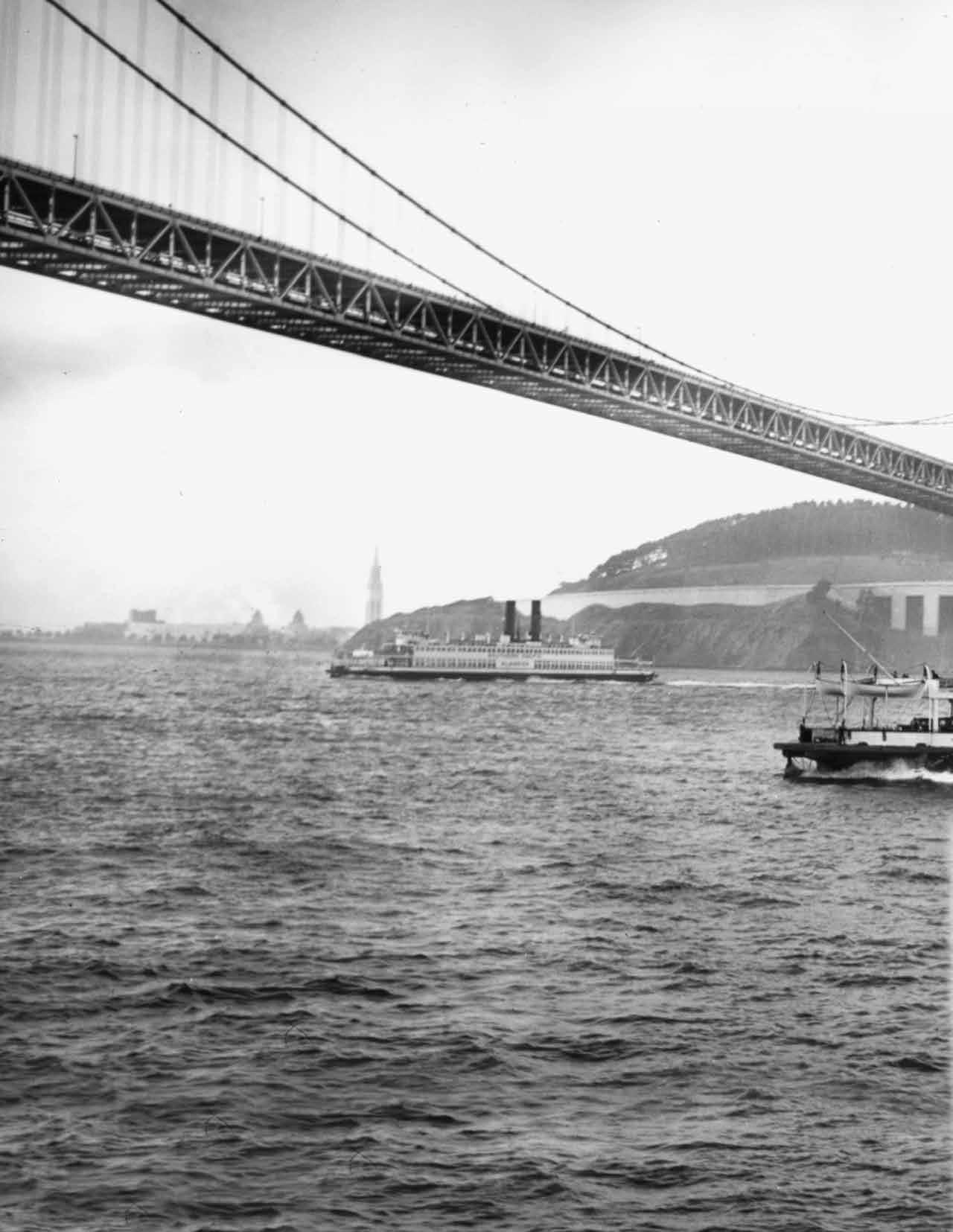
Heading for San Francisco in 1938, Berkeley approaches the Bay Bridge. Rising in the distance beyond the ferry Alameda are the buildings of the soon-to-open world’s fair on Treasure Island. The bridge that brought most visitors to the fair would ultimately spell the end for these ferries.
Courtesy California State Railroad Museum, 387-1228, No. 19242
Charles A. Bencik
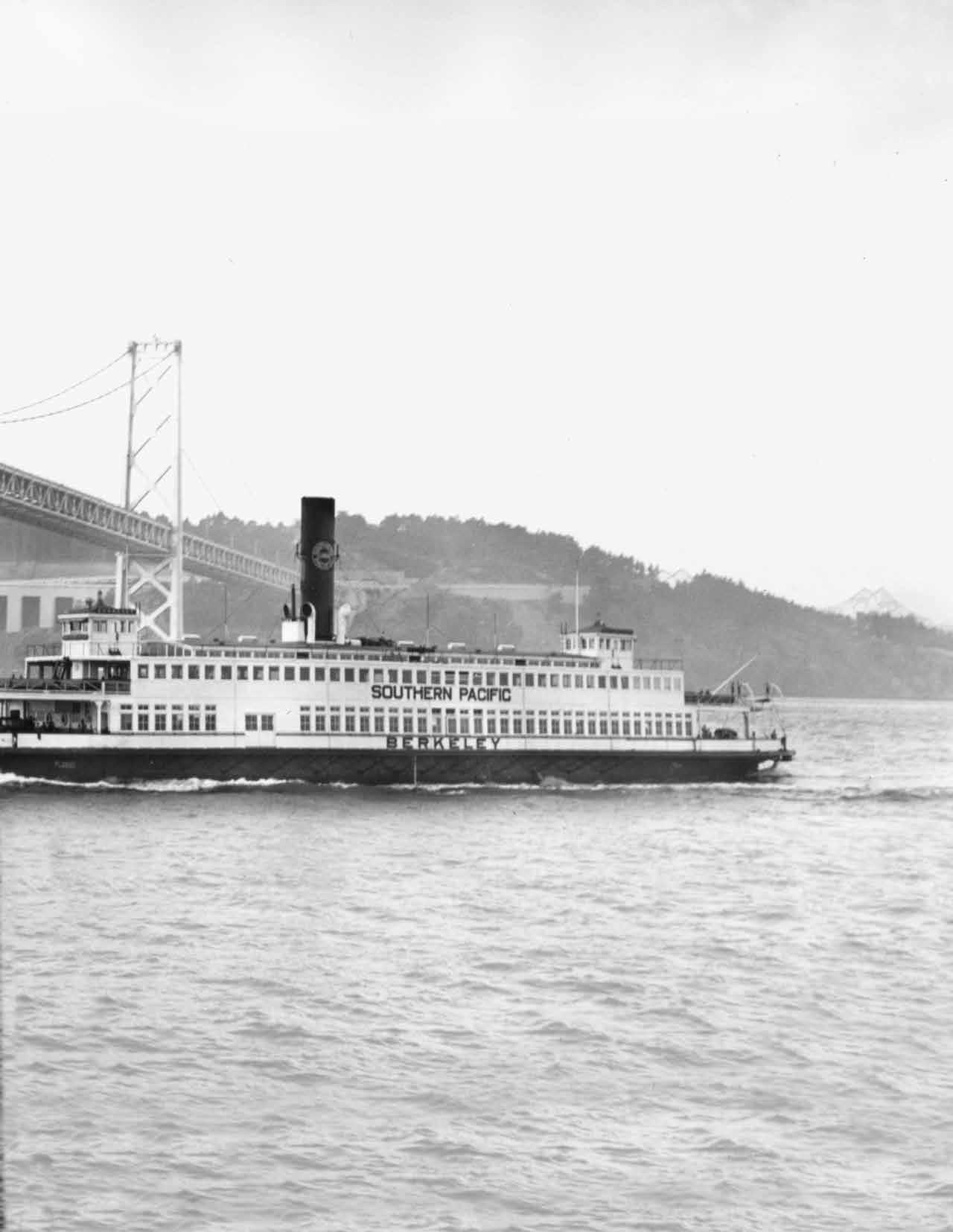
When asked in 1894 to comment on the qualities that were expected of a first-rate ferryboat, the president of the Hoboken Ferry Company had this to say:
You want, first of all, stopping power, after that some other qualities, such as handiness in steering, quickness in starting . . . but above all, and again, stopping power. The man who pays the bill will add economy in first cost and operation. These are the data of the designer. Every one will be perfectly content if the boat can make twelve or thirteen knots on her trial trip and hold the same number of statute miles at full speed on her route. The engineer must have an engine that he can repair quickly and cheaply, and that will do the backing when called on, and not stick on centres or churn up the water uselessly. The hull must be well shaped, so that it will steer quickly and will not sink at the bow when loaded by the head. It must [have] easy lines and, above all, must be staunch and strong and as nearly unsinkable as skill and money can make it.1
Ferryboats on both coasts adhered to these general principles, and nineteenth-century builders consistently chose paddlewheel steamers as the best design for ferryboats. In 1887 the San Diego and Coronado ferry service launched the world’s first propeller-driven double-ended ferry, Silver Gate. Unfortunately for those who sought a reliable, easy to handle, quick-stopping ferryboat, she proved wildly unmanageable and failed miserably.2 The following year, designers Edwin Stevens and J. Shields Wilson, of New York, launched Bergen. She proved far more successful and, after numerous trials, was considered a good alternative to paddlewheel-driven vessels.3 On the West
BERKELEY: A Pioneering West Coast Ferryboat
Chuck Bencik, of San Diego, was the Maritime Museum’s librarian for five years, and has contributed to or edited many Mains’l Haul articles. Chuck previously served as an officer aboard the steampowered Navy cargo vessel USS Castor; and conducted and supervised Naval Reserve training for almost two decades.
Coast, however, ten years passed before another propeller-driven ferry, Berkeley, would be constructed.
As the century drew to a close, San Francisco’s paddlewheel ferryboats, like those that traversed the waters around New York, Seattle, and San Diego, carried the city’s lifeblood—its laborers, businessmen, shopkeepers, and shoppers. Before bridges spanned San Francisco Bay, transcontinental railroad passengers were stopped at Oakland by a watery barrier that prevented them from reaching San Francisco, the hub of much of the Pacific’s commerce. Ferryboats provided the vital link that allowed railroads to continue across bays and harbors. In the late 1890s, Southern Pacific, which already operated a dozen ferries on the Bay, ordered Berkeley’s construction specifically for that purpose. The company envisioned Berkeley drastically increasing Southern Pacific’s trans-bay carrying capacity, providing better, more frequent, and more comfortable service for the growing number of commuters and transcontinental train passengers it served.
The double-ended, steel-hulled, propeller-driven steam ferryboat Berkeley was designed and built by Union Iron Works at an approximate cost of $122,000.4 The ferries of the Hudson River and New York Harbor influenced her design. Working with Southern Pacific Railroad, Irving M. Scott, the general manager of Union Iron Works, had traveled extensively, reviewing the plans for various eastern ferries in an attempt to design the most modern ferryboat ever built.5
Most of the engine drawings for the yet un-named vessel designated “Boat No. 55” were completed and approved in July 1897, with approval for the midship hull section drawings following a month later.6 Construction of machinery and engine components began that September.7 Debate over deck plans and furnishings continued until December 1897, when Southern Pacific’s General Manager Julius Kruttschnitt reported that the plans were complete.8
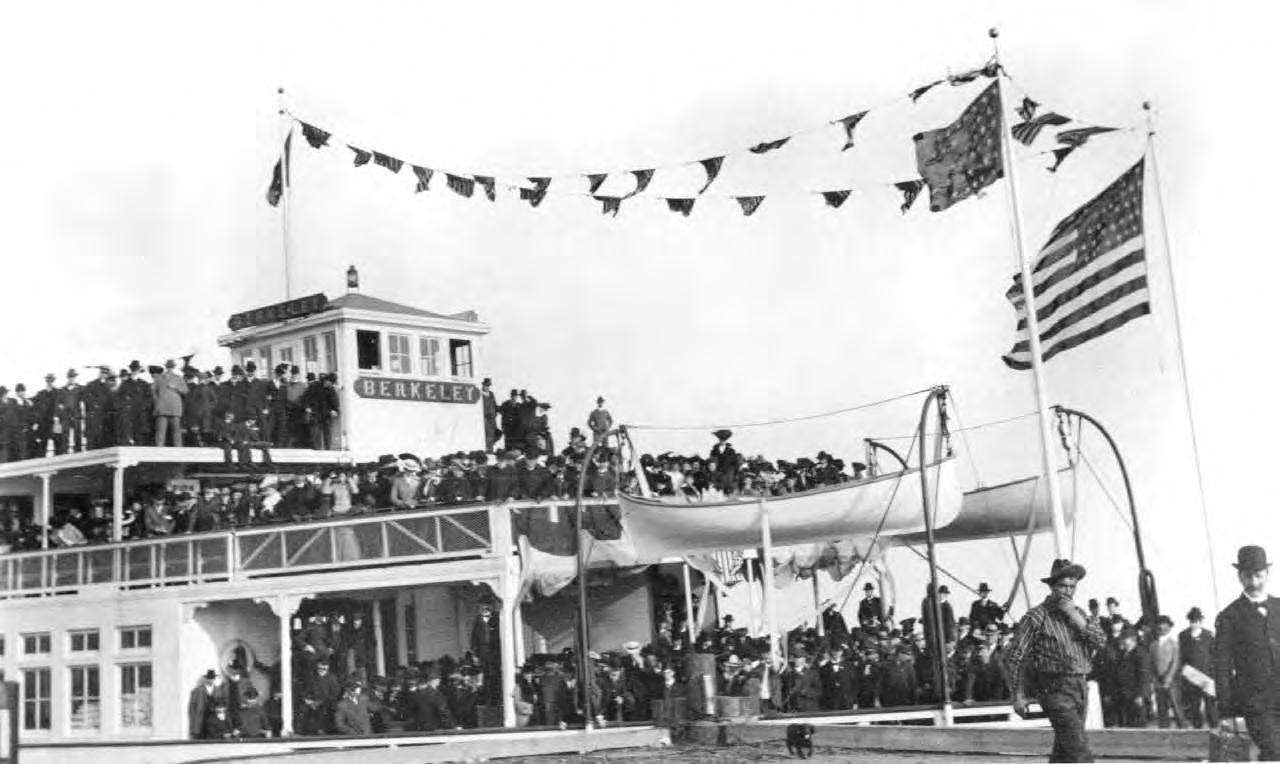
San Franciscans read in their newspapers that the Berkeley will be one of the largest and handsomest passenger ferry-boats in the world. In studying up [on] the details of the boat the officials of the Southern Pacific Company have had before them the plans and specifications of the new passenger ferryboats of the Pennsylvania Railroad, and the plans of the vessel now being built by the Union Iron Works call for a vessel that equals in accommodations and exceeds in size those of the Eastern railroad mentioned. The company has also profited by the experience afforded by its present boats, not only at San Francisco, but at Benicia, New Orleans and all other points where freight and passenger ferries are operated. There is no company in the country that operates so many car and passenger ferries as the Southern Pacific Company and this experience, together with the advantage afforded by the most careful and intelligent designing, has enabled the company to plan a vessel that will eclipse in every respect anything in the nature of a passenger ferry-boat heretofore operated on either the Atlantic or Pacific systems of the company.9
On January 25, 1898, Berkeley’s keel-laying ceremony took place. Her design called for an internal keel girder, not an external keel, a fact that would unfortunately make her less manageable than her builders hoped.10 For the next ten months Berkeley slowly took shape alongside the battleship Wisconsin, also under construction at the Union Iron Works yard. While work on Berkeley progressed, the new San Francisco Ferry Building opened for passenger service on July 14, 1898, replacing a wooden structure built in 1875. The new Ferry Building and newest ferryboat were both designed with two levels to speed loading and unloading. Passengers could step aboard either onto the main deck or directly onto her weather passenger deck through gates on her port and starboard sides at either end.
On October 18, 1898, about 2,000 invited guests came to witness Berkeley’s launching. University of California president Martin Kelly spoke and presented a set of flags from the people of her namesake city, which were accepted by the Southern Pacific’s president, Henry E. Huntington. A few minutes after noon, Huntington’s daughter Marian pressed an electric button that loosened the dogs holding the ferry in position next to the stillunfinished Wisconsin. As Berkeley slid down the ways, Miss Ruby Richards of the city of Berkeley christened her with champagne.11 On her launching day, she was the largest commuter-carrier in the country, with seating for 1,700 passengers, five hundred more than any other ferry on the Bay.
On October 22, Berkeley’s boilers were lighted, and she spent the day steaming on the Bay on a trial trip. She logged a speed of twelve-and-aquarter knots, and the San Francisco Chronicle reported that her primary architect, Irving M. Scott, supervised the trials and “expressed himself as well satisfied with his latest specimen of naval architecture.”12
On November 6, 1898, after Union Iron Works finished her construction, outfitting, and basic shipyard trials, Berkeley became the
As the new steamer Berkeley waits to leave the Ferry Building, a scow schooner serves as a reminder that sail still carried much of the world’s trade.
Courtesy San Francisco Maritime NHP


MMSD
first propeller-driven ferryboat on a bay full of sidewheelers. Her first three years of service, however, were marked by chaotic efforts to safely enter the ferry landings, as her captains wrestled to counter the Bay’s swift tidal current and frequent near-gale wind conditions.13 These first pilots found Berkeley’s peculiar handling qualities difficult to master and zealous newspaper writers gleefully reported her unruly behavior at every opportunity. During a ten-day period in December of 1898, reporters filed five stories related to the Berkeley’s inability to behave like a normal ferry. In the first of those articles, San Franciscans read that
the new ferry boat Berkeley has not yet been conquered by her navigators, and on Saturday evening while coming from Oakland with a large crowd of race track people tore into the slip on this side and mowed down about a score of stout piles. Nobody was hurt but for a few moments the utmost excitement prevailed. When the boat approached the slip as many as could crowded to the bow of the boat. This threw the after propeller and rudder out of the water, and the Berkeley took a wild rush at the side of the slip. The boat was damaged very slightly.14
On December 10, the Chronicle reported that the late arrival Thursday night of an unexpected nor’easter prompted Southern Pacific to ensure that Berkeley “was given no opportunity to further distinguish herself,” and was kept moored in Oakland.15
Two days later the Chronicle proclaimed that Berkeley’s career as a ferryboat was virtually over and, in effect, published her obituary:
THE BERKELEY A FAILURE SHE IS CONDEMNED
The Southern Pacific Company’s new ferryboat Berkeley after repeated trials and experiments, has proved herself to be completely unfitted for the service for which she was built. A conference of the officials of the Company was held on Saturday to consider the question of what should be done with the vessel, and at that conference, she was condemned as unserviceable. The Berkeley is now laid up at the pier and may never run again on the local ferry route across the bay.
Various reasons are assigned by the experts who have attempted to get at the cause of the Berkeley’s crankiness. In a strict sense of the word the boat is not “cranky,” and is as well and substantially built as any boat belonging to the company. The trouble is that she is not suited to the service, and her peculiar style of marine architecture does not permit her to be handled with the ease and precision required in a ferryboat that has to make quick stops in a swift tide. Under the most ordinary circumstances the Berkeley is unmanageable.
To get the necessary speed out of the boat her hull was built on fine lines, and
Maritime Museum of San Diego
results now prove that this was a severe error. It is learned that at the time the plans were originally submitted they were disapproved by an expert on the grounds that the ends would not support the weight of the passengers who crowd forward as the boat approaches the slip. The results of all recent experiments and trial trips prove this and offer a sad commentary on the intelligent designing of General Manager Kruttschnitt of the Southern Pacific, who is being held responsible for the failure.
The Berkeley, as is probably well known, is propelled by two screws, one forward and one aft, both attached to the same shaft. In approaching a slip the weight of human freight on the forward deck depresses the forward end of the boat from twelve to eighteen inches beyond her water line, and the stern necessarily rises out of the water just that much. This has an astonishing influence on the rudder. The vessel, under these circumstances, fails to respond promptly to her rudder, she becomes unmanageable, and only the greatest good luck saves her from crashing into the end of the pier. When the screw is reversed the rudder becomes utterly unserviceable. The propeller sucks the water away from it, and the boat, failing to respond to her wheel, proceeds in the direction of her own momentum in spite of all protests from her master.
Whether the Berkeley can be remodeled and made serviceable for the run between here and Oakland is a question. In the meantime the ferry service is badly demoralized and the thousands of commuters who have to patronize the boats to get to and from their daily labors are wondering how soon the promised twentyminute boats will be put on the run.16
On December 13, however, an article appearing in the Chronicle’s “Ocean and
Her engines at full astern, the aptly-nicknamed “pile driver’s friend” slews wildly into her San Francisco slip about 1917.
Courtesy San Francisco Public Library
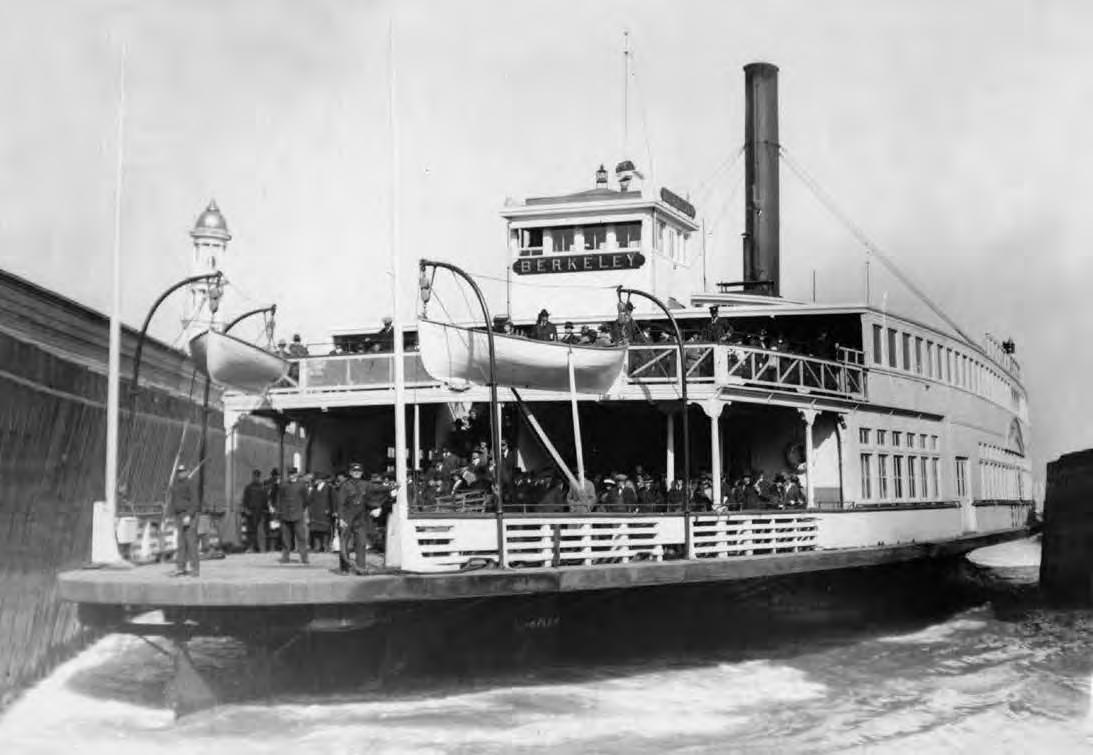
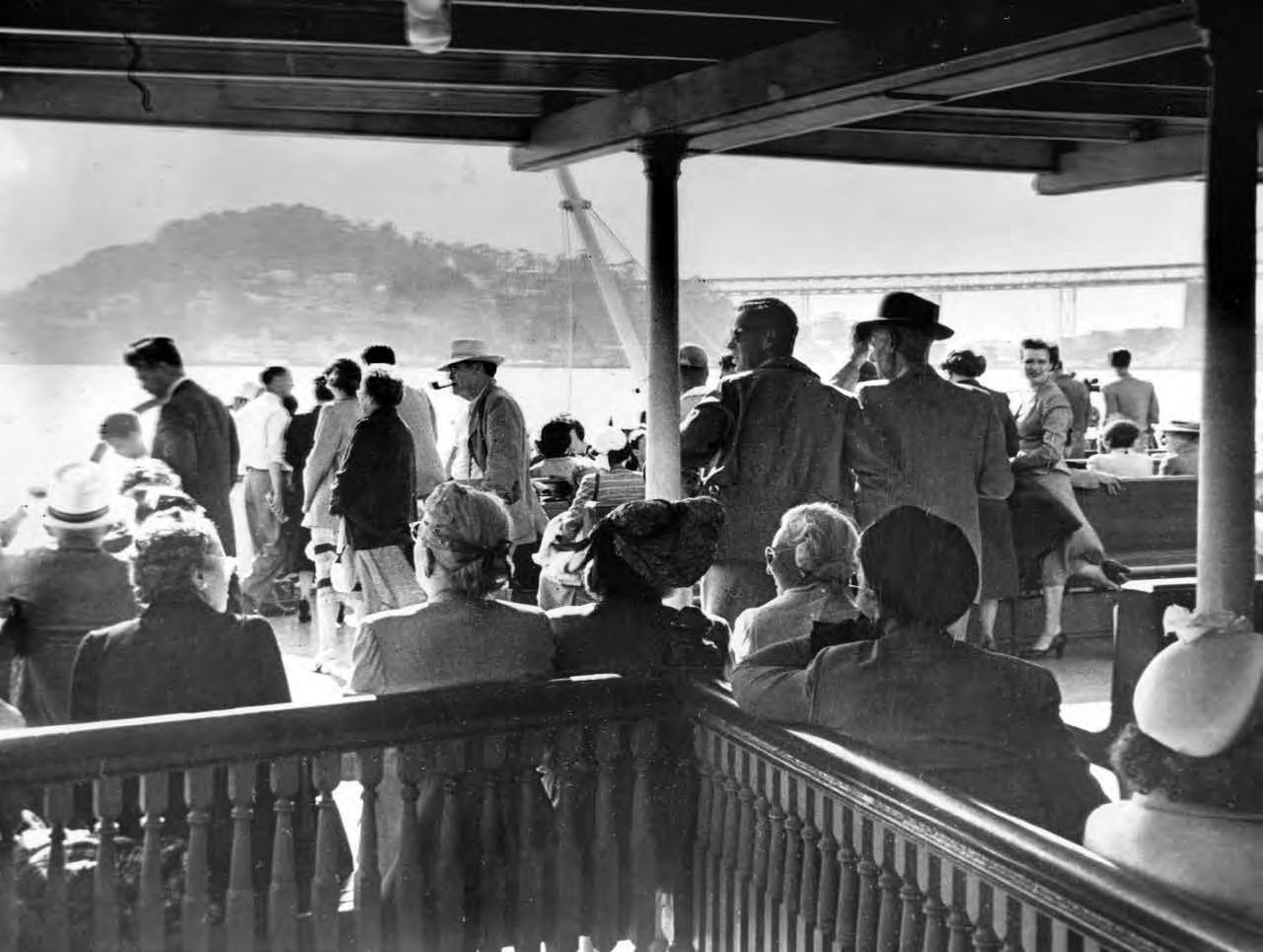
MMSD P2452
The wind having died down and the bay being smooth as a mill pond, the ferryboat Berkeley was used yesterday for a few trips during the daylight in connection with the Southern Pacific ferry system. The fact that she was used at all was chiefly because the peculiarly favorable weather conditions made it impossible for her to get very far astray. The conditions were taken advantage of to divert public attention from the numerous criticisms regarding the boat’s crankiness and to make the condemning process as gradual as possible. It is probable that by building a partition across the boat amidships and preventing any crowding toward the bow when the boat nears the slip the trim of the new boat may be preserved sufficiently well to make her fairly safe in fine weather, but no attempt will be made to use her either at night or when the wind is blowing with any degree of force. The Berkeley is purely an experiment, and, thus far, an unsuccessful one. Boats of similar design have been successful in the East, but she is larger than any other of her model ever constructed, and seems to have passed the limit in size for boats of her character.17
Unwilling to abandon a good story, the following day the columnist asserted that “the new ferry steamer Berkeley seems to have been pursued by an evil genius.” He addressed Berkeley’s behavior problems from the standpoint of the inordinate expenses already incurred during her short career:
When she was first brought to the slip on this side of the bay it was found that she would not fit and extensive alterations had to be made on the boat. Since then
she has wrought considerable damage to State property through her eccentric manner of making landings. On November 11th at 1:15 p.m. while entering her slip she struck the dolphin between slips 5 and 6. She struck it with considerable force, and the effects of the blow demonstrated the powerful construction of the vessel. She smashed seventeen piles and utterly destroyed about 6000 feet [of] lumber, and, in addition to creating a panic among her passengers, ran up a bill for her owners of more than $1000. She again ran amuck on the evening of December 3rd shortly before 6 o’clock, when she struck the dolphin between slips 6 and 7, again cutting into sections another cluster of seventeen piles and smashing up a little more State property. Thus far the Berkeley has to her credit thirty-four piles and a good many thousand feet of lumber in the shape of mangled ribbing, shocks and caps, and the bill that will have to be footed by her owners foots up more than $2200.18
During the early years of her career, storm conditions offered the best opportunities for reporters to point out Berkeley’s shortcomings. As her crew learned to handle her, however, those opportunities diminished despite conditions that occasionally wreaked havoc on the daily commute across the Bay. When a morning southeaster pummeled commuters with a driving rain propelled by forty-eight mile-per-hour-winds in 1900,
hundreds of passengers who had never experienced seasickness lost control of their stomachs under the heavy rolling of the boats. Sprays from the big seas dashed clear over the Berkeley, Oakland and Bay City, and their decks were constantly awash. The Berkeley had eighteen windows broken on her 10 o‘clock trip, one of them being a heavy plate glass port window in the wineroom, which is partially below decks.19
Though the Berkeley performed as well as any ferry, at least one commuter decided not to chance the twenty-minute return commute that evening and opted instead to take a two-hour train trip around the Bay to get home.20
On March 10, 1899 Union Iron Works personnel conducted builder’s trial runs while the ship was in service. During six runs between San Francisco to Oakland Berkeley’s speed was calculated at a very satisfactory 13.66 knots.21
Despite her favorable engineering trials, large capacity, and beautiful workmanship, Berkeley’s unmanageable nature while docking earned her the nickname “the pile-driver’s friend,” lending support to the arguments of those who, until well into the 1920s, maintained that walking-beam engines and sidewheel propulsion were superior for ferryboats.
When asked about these handling problems, Berkeley engineer Lawrence E. Bulmore wrote that the “poor old girl,”
was easily handled under full steam but had a habit of drifting with the tide under a slow bell. That is why she did so much damage to the slips in San Francisco. You will recall that the ferry slips in S.F. were shorter than those at Oakland and Alameda, therefore she could not be eased
in to S.F. on a slow bell. If the tide was running out the pilot would bring her almost to the pierhead and then, full astern with a jingle.
The beleagured pilot aimed for the slip “no doubt saying a prayer,” according to Engineer Bulmore.22
The new century brought new ideas for improving Berkeley’s propulsion plant. Early in 1901 Southern Pacific replaced her bronze propellers with iron ones. A more fundamental change came later that year when her owners converted Berkeley’s boiler from burning coal to burning oil.23 Southern Pacific had begun experimenting with oil-burning locomotives as early as 1879, since oil was proving to be a more efficient fuel than coal. Southern Pacific’s conversion to oil was completed shortly after the turn of the century.
At the same time, Southern Pacific tried to improve Berkeley’s public image. When a national convention of the Episcopal Church was held in San Francisco in October, 1901, Southern Pacific donated the ferry for a Sunday afternoon tour of the Bay. The Chronicle spoke well of “the big ferry steamer Berkeley, spic and span in a new coat of paint, her brass fittings highly polished, and the decks holystoned until they looked like new planks.” While crossing from Sausalito to Fort Point “the sun was just at the right angle to make the Golden Gate show in all the glory which has made it famous.”24 Doubtlessly, like visitors before and since, the Episcopalians remarked on the church-like appearance of the clerestory’s stained glass windows. Berkeley was indeed beginning to appear in a better light to the public, as her owners hoped. Eventually the novelty of Berkeley began to wear off. As the crew mastered her idiosyncrasies, fewer sensational accidents brought unwanted attention from newspapermen. In November 1901, three years after her launch, Berkeley officially started regular service on the Oakland to San Francisco run.25 For the next fiftysix years, she alternated her service time between the Oakland-San Francisco run and the Alameda-San Francisco run, with an occasional stint as a substitute ferry between Sausalito and San Francisco. She often transferred from one route to another in order to replace a damaged or out-of-service ferry.26
On the morning of April 18, 1906 San Francisco experienced a monstrous earthquake, estimated at 8.3 on the Richter Scale. Southern Pacific’s offices, on soft ground near sea level, collapsed into a pile of bricks Thousands fled the aftershocks that followed and the devastating fire that swept the city. Berkeley joined more than thirty other ferries in carrying refugees to Oakland and bringing fire fighting equipment, food, clothing and medicines to San Francisco. Captain Nicholas Nelson was on the Berkeley for three days without relief, loading and leaving on no particular schedule.27 In the immediate aftermath of the disaster, ferry service remained one of the few familiar aspects of their old lives that Bay Area residents were still able to count on. This was due in part to the survival of the Ferry Building with little damage.
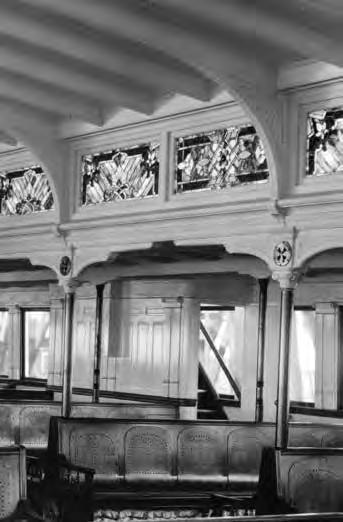
Originally the only access to the pilothouses was this stairway, located where the women’s restroom is today. The extraordinary stained glass windows were by California Art Glass Studios, whose San Francisco workshop is shown below as it appeared around 1898.
MMSD P12003
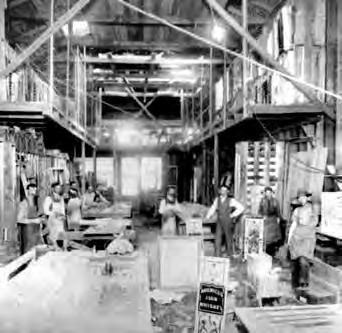
Earthquakes had no affect on the ferryboats themselves, but time brought a number of changes to Berkeley’s appearance during her long career. Around 1917, a pair of stairways were installed at each end linking her main and saloon decks, replacing the single sets of stairs originally located there. Three windows were added on the saloon deck level at each end, to enclose the “veranda” beneath her pilothouses and give additional protection to the new stairways. Her narrow smokestack was replaced with one having greater crosssectional area. Access to the pilot houses was improved through the construction of stairs leading directly to each pilothouse from the saloon level, replacing the only previous access, a narrow stairway which reached the hurricane deck amidshps from the present-day site of the women’s restroom.28 Probably in the early 1930s, a snack bar was installed on the saloon deck.29
Berkeley’s original design featured a restaurant, with an adjacent bar (or wine room) and a men’s restroom on the lower level. In 1920, when a record 195,000 passengers took the ferry between Oakland and San Francisco, the Volstead Act went into effect and Prohibition began, closing the bars on Southern Pacific’s ferries.30 Reportedly, not a single drop of liquor was taken ashore from Berkeley by the Commissary Department. Instead, passengers and crew “celebrated” the onset of Prohibition by purchasing the liquor, while the officers walked away with complimentary bottles.31
Maintenance of the ferry’s machinery was a constant headache. Nuts loosening from bolts and studs were particular concerns. Lawrence Bulmore offered the following tale from Berkeley’s engine room:
The Chief of the crew that relieved us was very strict about having every thing checked as soon as he came on watch. One day my oiler spent much of the watch polishing a 3/4 nut. When we went off watch he dropped it into the crank pit and told me what he had done. There was a crew between us but when we returned there was a l-o-n-g letter waiting for me. The Chief’s oiler had found the nut and as it was bright he thought it had fallen from a stud on the main engine and told his Chief about it. The Chief was sure it belonged on the engine some place and had the oiler go over the entire engine looking for a stud without a nut. Of course none was found. When that crew relieved us the next watch I told the Chief what my oiler had done, assuring him it was intended as a joke, but he was not in good humor and his oiler said things to my oiler that cannot bear repeating.32
In 1930, Southern Pacific operated forty-three ferries on San Francisco Bay, carrying mail, luggage, express, and forty million passengers a year. The Berkeley had been lauched when horses provided most of the world’s road transport, but the new auto ferries also carried an average of 15,875 vehicles per day, a number that increased to 29,400 on weekends and holidays.33
The Depression years strained the treasuries of transit systems worldwide. 1936 marked Southern Pacific’s first profitable year following the onset of the Depression. On November 12, 1936, however, the San Francisco-Oakland Bay Bridge opened, and automobiles began driving across the Bay. Southern Pacific declared it would not abandon auto ferry service, but it proved an empty promise. On January 15, 1939, Oakland completed the last auto ferry run between Alameda and San Francisco. At the same time, commuter train traffic started on the Bay Bridge’s lower deck.34
When the bridge was new, the distinguished author and deep-sea yachtsman Captain Lincoln Colcord arrived by train in Oakland:
Friends met him when The Overland Limited got in, and escorted him, aboard the Berkeley, to San Francisco. As they passed under the then-new East Bay Bridge, his friends silently watched the thin-faced man from Maine as he looked aloft at the steelwork of San Francisco’s pride and joy—or perhaps “glared aloft” would be the better term. His reaction to the bridge came quickly. “God!” he said, “Why did they let them do that?” 35
Though the ferry systems declined, Berkeley remained in service. Treasure Island, a new
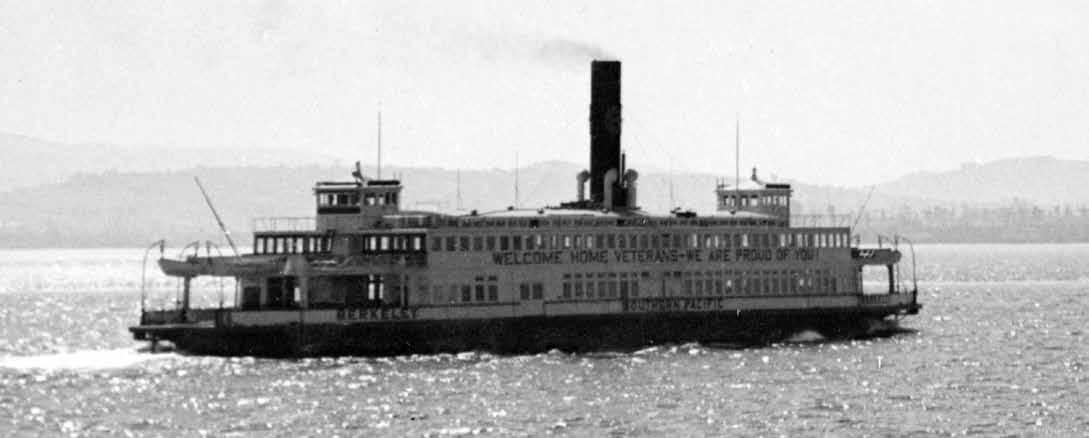
praised returning veterans. She was also decorated for Christmas and for occasions like the annual “Big Game,” in which half the vessel would be decorated in Stanford red, and the other half in University of California colors.
Courtesy The Bancroft Library
Bay landmark, had been created by depositing dredged material onto a shoal adjacent to Yerba Buena Island. In 1938 Berkeley ferried workmen out to the new island to construct the buildings for the Golden Gate International Exposition. During that world’s fair in 1939 and 1940, Berkeley joined the ferries of the Key Route, one of the Bay’s other ferry systems, in carrying tourists to and from Treasure Island. 36
During the Second World War, the demand for public transportation exploded as urban California’s population swelled with the influx of laborers, soldiers, sailors and their families. Commuters resigned themselves to travel by bus, streetcar and ferry, and the nation relied on passenger trains. By the late 1940s, however, automobile and transcontinental air travel expanded at the expense of the Southern Pacific and other railroads. Tourists, vacationers, and nostalgic ferry buffs, sensing the future, started replacing commuters on the ferries. San Leandro became the regular ferryboat assigned to the Oakland-San Francisco commute, while Berkeley remained on stand-by duty.37
The postwar years brought declining ridership but technological improvements. To pierce the Bay’s frequent fogs, Southern Pacific installed the first radar equipment on one of its ferries in 1947. Passenger Winn Bagley remembered riding Berkeley in “fog so thick that the forward handrail was not visible from the center of the vessel.”
We passengers stood around peering into nothing, hearing the various whistles with their mysterious charm echoing back and forth across the water like voices from another world. Soon we would see a glare, hear the Berkeley ring for dead slow as our captain gave a short whistle blast and heard another blast from the oncoming ship. As the ships passed eerily by each other, our passengers strained to make out the ghostly form slipping away . . .38
Berkeley received radar antennas atop both pilot houses in 1953.39 The following year, she reportedly became the first Southern Pacific ferryboat with a ship-to-shore telephone.40 A pay telescope (price ten cents) was mounted at each end of the saloon deck for tourists, suggesting the ferry’s transformation from daily commuter to tourist use.
In 1957, Berkeley’s function as a train passenger ferry ended, as Southern Pacific began transporting its passengers by bus from Oakland.41 While she continued to provide passenger service to the Oakland pier, the end of ferry service was clearly at hand. According to a magazine catering to the growing ranks of steamboat aficionados,
The former S. P. commuters hoped that, since the beam engine boats were gone, Berkeley might be running at the last, the grand, beautiful old Berkeley that had carried S. P. commuters and mainline passengers for over half a century.42
In the spring of 1958, however, Berkeley was taken out of service for repairs, denying her the privilege of playing an active role in the final days of the ferries. On July 29, 1958 ferry service ended as the more modern turbo-electric-powered San Leandro made the last runs between San Francisco’s Ferry Building and the Oakland Mole.
Following the demise of ferry service, the Golden Gate Fishing Company purchased Berkeley on January 26, 1959, intending to convert her into a whale reduction vessel on the Oakland estuary, a sad (and smelly) end for a grand vessel. In August, however, businessman and ferryboat enthusiast Luther “Bill” Conover declared himself the sole owner of Berkeley, and for two years he fought Golden Gate Fishing Company for ownership. Golden Gate finally sanctioned the sale of Berkeley to him in August, 1961.

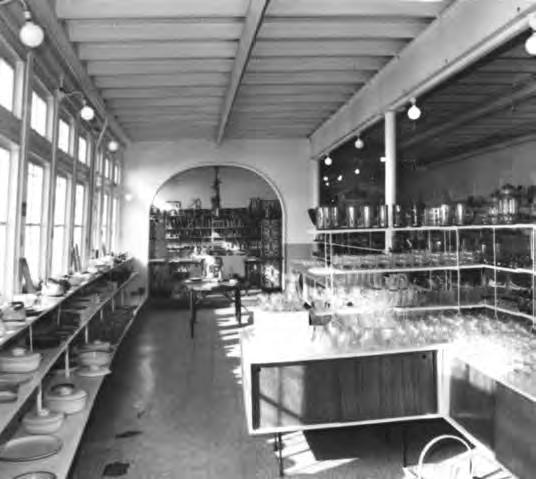
Transformations: The main deck originally featured space for benches and baggage carts. In 1972, moored in Sausalito, the deck housed the gift store “Trade Fair.” Today, visitors encounter maritime history exhibits in the same space
MMSD P11718, P2045, 2002 photo by John Wright

Bill Conover moved the ferryboat to the old Northwestern Pacific ferry pier in Sausalito, and attempted to prepare her for redocumentation and restoration as a working ferry, but costs proved prohibitive.43 Instead, he opened Berkeley as the floating gift shop “Trade Fair,” which she remained for fourteen years. With the store’s exposure to occasional heavy weather, now and then a customer became seasick.44
Conover fitted her out with glazed windshelters fore and aft on the ends of the main deck. For want of emergency fire exits, the engine room and the ornate upper deck were left alone, shut off from public access by order of the Sausalito Fire Department. Her aft pilothouse for a time became the haunt of actor and sailor Sterling Hayden. “Sterling rented the pilot house on the Berkeley and rowed across the Bay every morning from our house in Belvedere to his pilot house office,” recalled his wife Kitty. There, friends remembered, they would climb to the pilothouse “to have a gam and a snort with him when he was writing the book,” published in 1963 as Wanderer. Hayden would later miss the view from his “ivory tower:” a “straight shot,” he recalled, to Alcatraz, Angel Island and the shipping channel, with San Francisco rising beyond.45
In early 1972, the board of trustees of the San Diego Maritime Museum, which then consisted solely of the tall ship Star of India, were seeking a site ashore for a museum building. Instead, they hit upon the idea of a floating museum. The memory of the San Diego and Coronado ferry system, shut down in 1969, was still fresh, and the possibility of acquiring a San Diego ferryboat came to mind. The board decided that the retired diesel ferry Coronado, however, was too small, badly vandalized, and overpriced. They also considered the Canadian National Railway rail car ferry Canora Three excursion steamers (one on the East coast and, therefore, too expensive to tow) also proved unacceptable.46
In November, 1972 Board President Bob Sharp and Captain Ken Reynard, the Museum’s Director of Restoration, made some computations of the costs to purchase, restore and maintain Berkeley. She promised to provide four times the Star of India’s available space for exhibits and offices. First, however, they needed to haul her out for a safety and preservation check.47 At length, the board reached a decision. After months of inspections, drydock work, and other preparations, board member Paul Kettenburg announced that the hull was sound. Many in the Bay Area, however, regretted the idea that Berkeley would leave. When asked by a Northern California newspaperman about the asking price, Ken Reynard replied testily “that’s nobody’s business but ours.” The sum of costs to purchase, prepare, and tow her to San Diego was about $100,000.48
On May 31, 1973, the tug Blue Eagle took her in tow, and, at 12:44 P.M., Berkeley passed under the Golden Gate Bridge and headed for sea, watched by a few “rail fans” on an excursion boat and a small coterie of historians. In preparation for the voyage, her forward propeller and rudder had been stowed on her stern, and plywood covered her main deck windows, giving her a slight orange tint from a distance. From her stern, a line with a buoy at its end
trailed in the water, a precautionary measure in case her tow line broke and the tug needed to regain control.49 Three days later, on June 3, they entered San Diego Bay and PacTow tugs Coronado and Palomar brought her to the “B” Street Pier, where restoration work commenced almost immediately.
By mid-1974, exhibits began appearing on Berkeley’s main deck. The first showcased local oceanography and fisheries. Meanwhile the Navy League’s San Diego Chapter began helping the Museum collect artifacts and materials for a Navy-oriented display, and the museum’s model makers began work on an exhibit about San Diego ferryboats. Hopes were expressed that the restaurant compartment would be restored some day.50 In the mid-1980s, the museum’s fleet shifted from “B” Street to a berth alongside the Embarcadero, near Anthony’s restaurant.51
Berkeley became a National Historic Landmark in 1991, and a California State Landmark in 2000. She survives as a floating reminder of a bygone era when even commuters could expect to travel in elegance and style, at least for an eighteen-minute voyage. Today she continues to serve the public as the Maritime Museum of San Diego’s principal exhibition hall, library, archives, collection storage, maintenance center, and administrative offices.
The first successful propeller-driven ferry on the West Coast has endeared herself to generations of riders and museum visitors. She lingered in the memory of many a Bay Area resident, who recalled the sound of her distinctive whistle:
The Berkeley was a boat of great beauty, one of the most distinguished on the Bay for sixty years. Her voice was certainly in a class by itself. To hear it was a memorable experience, evoking emotions akin to those aroused by the sight of a child on roller skates for the first time, or the sound of a 14-year-old boy trying to sing. The whistle started bravely with an earnest hiss of escaping steam; the sound progressed tentatively, hovering between a wheeze and a snore, until it finally reached its triumphant climax in a breathy and uncertain toot!52
1 Col. Edwin A. Stevens quoted in Cassier’s Magazine VI (August 1894): 285.
2 In 1887, at Coronado, California, Christian Telson built the 187’, 528-ton Silver Gate at a cost of $400,000 from Union Iron Works’ plans. During construction Telson increased her length and added a second deck, making her too heavy for her engines. Instead of proving the superiority of the propeller, however, after launching on 15 November 1887 she failed miserably. Pilots were never able to handle her and she repeatedly crashed into slips until she was finally laid up in the summer of 1888. Telson’s prior claim to fame had come during the American Civil War, when he raised USS Merrimac and converted her into the Confederate ironclad CSS Virginia
3 Bergen was built by C. L. Delamater Iron Works and launched by T. S. Marvel & Co. in Newburgh, New York. She was driven by a propeller at each end of the same shaft, with a single deck atop her hull. J. Shields Wilson designed Bergen’s most important innovation: her 800 h.p. triple-expansion engine. After her breaking-in period on the Hudson, Hoboken Ferry Co. arranged an exhaustive comparison between Bergen and Orange—a similar-sized steel-hulled, beam-engined, sidewheel 1886 ferry—first, during 14 hours in regular service, then non-stop over a 120-mile course. Finally, Bergen made several runs over a 2-mile course to measure her performance using only one propeller. Careful measurements of fuel consumption and work output generated a large amount of data, and technical papers were read at professional maritime organizations for some
years. Stevens announced that Bergen had proved superior. Her length was 200.4’, breadth 37’, and depth 16.6’; gross tonnage 1120, net tonnage 746. Raymond G. Baxter and Arthur G. Adams, Railroad Ferries of the Hudson and Stories of a Deckhand (Lind Publications: Woodcliff Lake, NY, 1987), 124.
4 The exact construction cost of Berkeley remains undetermined. The low-end figure appears on her earliest wreck report, 2 October 1900, under “estimated value of vessel.” The high-end figure, designated as an estimate, appears on an undated Southern Pacific document with an appended notation, in a different hand. It is possible this figure is based upon the construction contract base of $122,000 plus all additions and modifications made between her launch and November 1901, when she entered regular service. MacMullen Library, Maritime Museum of San Diego (hereafter MMSD).
5 Collis P. Huntington assumed the presidency of Southern Pacific Railroad (hereafter SP) in 1890 and promptly relocated the headquarters to New York. it is reasonable to assume that he was aware of the success of Bergen and the other propeller-driven ferryboats in New York. When the time came for Union Iron Works (hereafter UIW) and SP to design Berkeley, Huntington may have pointed to these ferries as a model. UIW president Irving M. Scott was likely familiar with Bergen as well.
6 Dated drawings, San Francisco Maritime National Historical Park, Bethlehem Steel Coll. (hereafter SFMNHP), HDC 345, copy at MMSD; San Francisco Chronicle (hereafter Chronicle), 7 December 1897.
7 An undated hold-level Berkeley plan shows two alternative arrangements. 1) Crews’ quarters forward of boilers with restaurant astern of engines, or 2) restaurant forward of boilers with crews’ quarters astern of engines. The latter design prevailed. MMSD; Erica Toland to Robert Crawford, 30 June 1997, MMSD.
8 At the time of Berkeley’s launch, Julius Kruttschnitt was SP general manager. He later served as executive committee chairman (1913-25) and company president (1918-20). Bill Yenne, The History of the Southern Pacific, (New York: Bonanza Books, 1985).
9 Chronicle, 7 December 1897.
10 San Diego’s much later diesel ferry Coronado had similar construction, which gave her similarly startling idiosyncrasies. Jerry MacMullen reported that “out in the middle of the bay the Coronado was fine, but entering the slip under slow bell, she might at any moment decide to go sideways instead of straight ahead.” MacMullen, “The Museum That’s Coming,” San Diego Union, 27 May 1973.
11 Chronicle, 19 October 1898. On launching, her mean draft was 7’10.5”, and she carried six tons of coal and full water tanks. Engineering News, 28 December 1898.
12 Chronicle, 23 October 1898.
13 Millions of cubic feet of water flow through San Francisco Bay daily, creating rapidly changing currents. In 1930, the maximum ebb tide past San Francisco’s ferry slips was 2.5-3 knots, while flood tide currents off the Oakland Mole were 1.5 knots, 1.9 knots around Goat Island, and 2.9 knots from mid-channel to the Ferry Building. U.S. Coast and Geodetic Survey, “San Francisco Bay” chart, 1 930, MMSD; Ibid., United States Coast Pilot, Pacific Coast, California, Oregon, and Washington (Washington, D.C.: Government Printing Office, 1926), 98-102; Chronicle, 1 January 1900; Berkeley Wreck Report 14 January 1932, MMSD.
14 Chronicle, 5 December 1898.
15 Ibid., 10 December 1898.
16 Ibid., 12 December 1898.
17 Ibid., 13 December 1898.
18 Ibid., 14 December 1898. A dolphin is a cluster of pilings serving as a mooring.
19 Ibid., 2 January 1900.
20 Commuting between SF and Oakland by train covered nearly 100 miles, versus the 3.5 mile trip across the Bay.
21 In these trials she recorded a mean indicated horsepower of 1163.66, while maintaining 122.5 r.p.m. Only one “annoying circumstance” marred the trials: fingerlings from spawning fish nearly clogged the inlet of her condenser tubes. SP later replaced the strainer to the circulating pump suction with one with smaller holes. Naval and Marine Engineering Journal 4 (August 1899): 52. C. E. Ward, an SP vice president, stated that Berkeley “produced 1125 horsepower.” Ward to C. Ray Wilmore, 1 February 1973, MacMullen Collection, MMSD.
22 Lawrence Bulmore to MacMullen, 27 June 1973, MacMullen Collection, MMSD.
23 “General Arrangement, Tanks and Oil Pipes, SP Co., Stmr Berkeley West Oakland Nov 11 1901,” SFMNHP, copy at MMSD; 1910 vessel description document included in Ward
to Wilmore, 1 February 1973; Harry Cottrell to Richard Brown, 21 May 1992, Brown Collection, MMSD; Crawford, “Steam Engines in the San Diego Maritime Museum,” Mains’l Haul 30 (Spring 1994): 4.
24 Their counterclockwise tour of the Bay took them from the Ferry Building past Hunter’s Point, then Alameda, Oakland, Angel Island, Tiburon, Sausalito, Fort Point, and along the waterfront back to the Ferry Building. Chronicle, 13 October 1901.
25 Ward to Wilmore, ibid. While the December 1901 New York Nautical Gazette reported Berkeley’s assignment to this regular run, no mention appeared in the Chronicle. See also Robert M. Parkinson to MacMullen, 9 July 1973 and 12 September 1973, MacMullen Collection, MMSD, quoting Earle Heath’s Bay Memories, a reprint of articles in Southern Pacific Bulletin
26 Brown to Craig Arnold, 27 May 1992, MacMullen Collection, MMSD.
27 Nicholas Nelson’s grandson, William Rustad, quoted in Louise Teacher, “The Berkeley Takes New Orders,” Marin This Month (March 1960): 10-11. San Diego’s Naval Militia was one of many units mobilized after the disaster as a part of the state’s emergency defense apparatus. They arrived in the city by ferry a little over a week after the earthquake.
28 Ev Mills, editor, Rail and Water (North Highlands, CA: History West, 1981), 13; Ward to Wilmore, 1 February 1973; Brown to MacMullen, 14 November 1973.
29 The date that Berkeley’s refreshment stand (a Prohibition-era substitute for the bar) was installed is unknown, though on 22 April 1928 the ferry system’s first soda fountain or refreshment stand opened aboard Alameda. Similar stands were installed on Berkeley and other SP ferries. According to Bulmore, after the repeal of the Volstead Act in 1933, beer was included on snack bar menus, although extant photos of the snack bar and menu signs do not confirm this. Mills, Rail and Water, 56; Bulmore to MacMullen, 28 April 1973, MacMullen Coll., MMSD.
30 Mills, Rail and Water, 11. At the onset of Prohibition, all SP ferries except Transit were equipped with a bar.
31 Bulmore to MacMullen, 28 April 1973, MacMullen Coll., MMSD.
32 Ibid.
33 Yenne, History of the Southern Pacific, 91.
34 “Southern Pacific Co. - Register,” SFMNHP, HDC 1044; Parkinson, “West Coast,” Steamboat Bill (December 1958): 103. Ferryboats slightly outlasted bridge commuter trains, which were replaced by buses on 20 April 1958.
35 MacMullen, “Maritime Museum Companion to the Name Trains,” Bridge and Bay, Summer 1974.
36 Brown to Arnold, 27 May 1992; Cottrell to Brown, 21 May 1992, MMSD; Parkinson to MacMullen, 14 July 1973; Bulmore to MacMullen, 28 August 1973, MacMullen
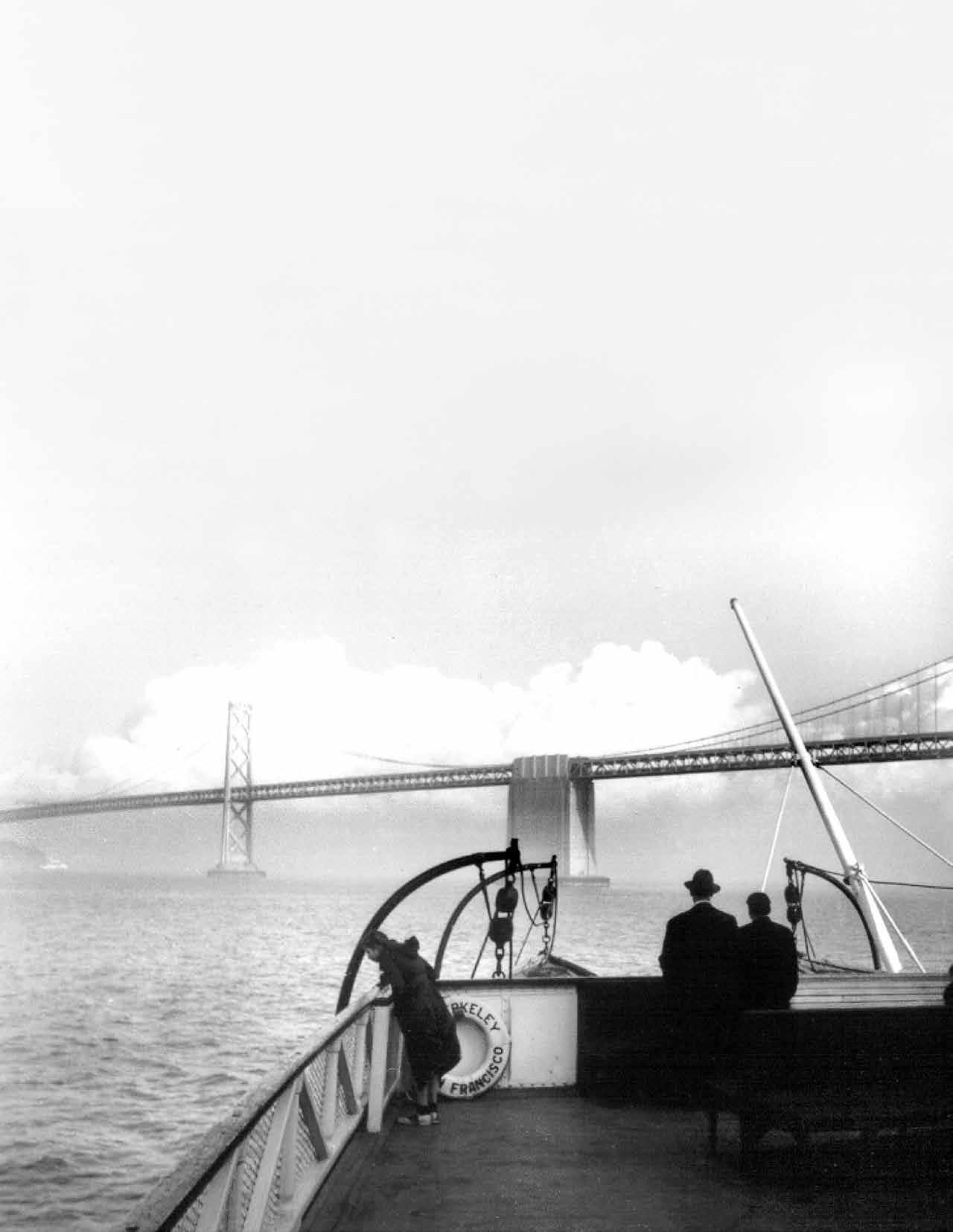
Coll., MMSD.
37 George H. Harlan, San Francisco Bay Ferryboats (Berkeley: Howell North Books, 1967), 117-121.
38 Winn J. Bagley, “My Recollection of the Berkeley,” Mains’l Haul 23 (Spring 1987): 4.
39 According to Berkeley Captain Hans H. Valentine, her radar was installed in April, 1953. “Ferryboat Skipper Ends 49-Year Career on Bay,” Oakland Tribune, 5 November 1953.
40 Bulmore stated that the phone was installed 15 June 1954. Bulmore to MacMullen, 28 August 1973, MMSD. If true, this is a rare exception: according to Harlan, “the radiotelephone was in its infancy when the ferries ceased to ply the waters of the Bay, and no attempt was made to place this facility on board the boats as long as ferry service was maintained.” Harlan, San Francisco Ferryboats, 55.
41 MacMullen, “Maritime Museum Companion.”
42 Parkinson, “West Coast,” Steamboat Bill (December 1958): 103-104.
43 Although Berkeley’s service officially ended 5 September 1958, her license did not expire until 19 November. “Trade Fair” had begun as a summer outgrowth of Conover’s furniture manufacturing business at Marinship, and by 1959 was a successful year-round downtown Sausalito store claiming to be “the largest gift store in the West.” “Marin’s International Market,” Marin This Month (June 1959): 12-13.
44 Harlan, San Francisco Ferryboats, 161.
45 Kitty Hayden, email to Luke Conover, May 2002, MMSD; Brooks Towns, email to Mark Allen, 4 February 2002, MMSD; Towns, book review, Wooden Boat 148 (May/ June 1999): 123.
46 Parkinson, “West Coast,” Steamboat Bill (Fall 1973): 162.
47 Drydocking, preparation and towing costs were shared equally by Conover and the Museum, which was billed $59,140 for its share of these expenses. Willamette Iron and Steel Co., invoice no. T 5-30 S-R No. T 2919, 30 May 1973, MMSD.
48 San Jose Mercury, 21 April 1973.
49 MacMullen, “Museum That’s Coming.” In 1982, aided by donations from the Propeller Club and Dobson Welding, the Museum mounted one 6,000-pound propeller (never refitted after her voyage south) as a dockside display.
50 Parkinson to MacMullen, 1 June 1973.
51 MacMullen, “Maritime Museum Companion.”
52 Harlan, San Francisco Ferryboats, 63.
Berkeley was photographed in 1956, above, near the end of her working career, while the 1914 postcard below shows her early appearance. At first glance, little seems different other than the addition of radar antennas atop the pilothouses, but almost six decades of hard use brought many small changes.

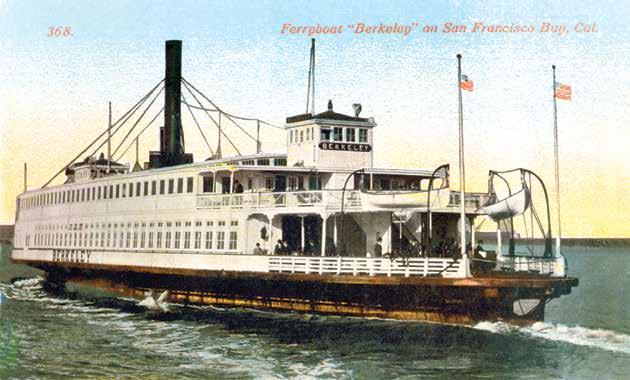

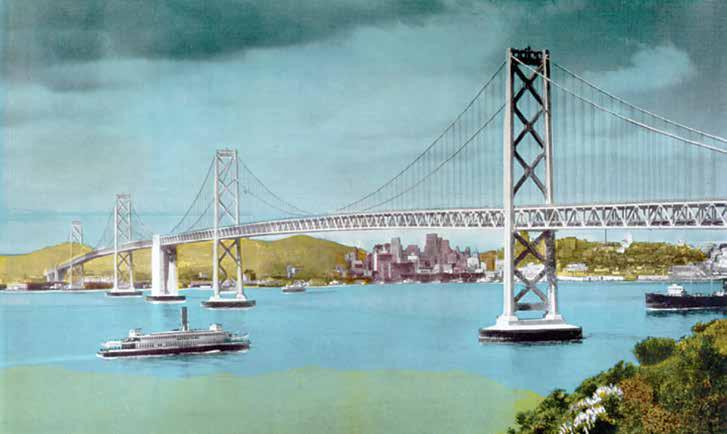
Tinted postcards show the hub of San Francisco’s ferry system, and the bridge which would spell its end. At top, a 1911 card shows Berkeley leaving San Francisco and the ferry Newark behind her. Below, she heads under the bridge, bound for “The City,” after 1936.
MMSD PC1250, PC1266-A
Maritime Museum of San Diego

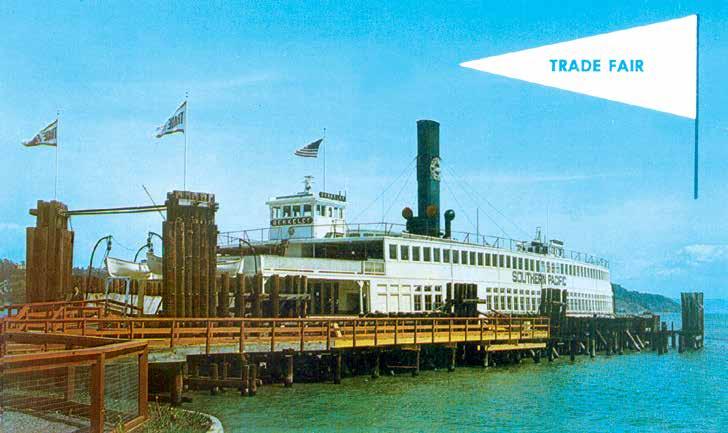
BERKELEY: A Pioneering West Coast Ferryboat
This birdseye view of Union Iron Works’ shipyard was made for the company’s first catalogue, six years before Berkeley was launched there. At bottom, a group of warships built at the yard are gathered for an imaginary reunion. Bracketing them are two that would gain fame in the Spanish-American War: at left, the battleship Oregon, and at right, the cruiser Olympia, Admiral Dewey’s flagship at the Battle of Manila Bay. The inset image at top left shows a triple-expansion engine like Berkeley’s, and the cruiser for which it was built. At top right is a compound engine for a double-ended ferryboat, from the same era as the engine built in 1887 for San Diego’s ill-fated Silver Gate.
The steel out of which Union Iron Works built Berkeley came from Pennsylvania. Pencoyd Steel of Lower Marion poured Berkeley’s steel at about the same time that they had a more unusual project underway: sending girders and a team of engineers to bridge the Nile River. Built in 42 days, the bridge was constructed to allow General Kitchener’s Anglo-Egyptian force to invade the Sudan. A month before Berkeley was launched in San Francisco Bay, the British won history’s last great cavalry battle at Omdurman. In the charge was a young trooper named Winston Churchill.
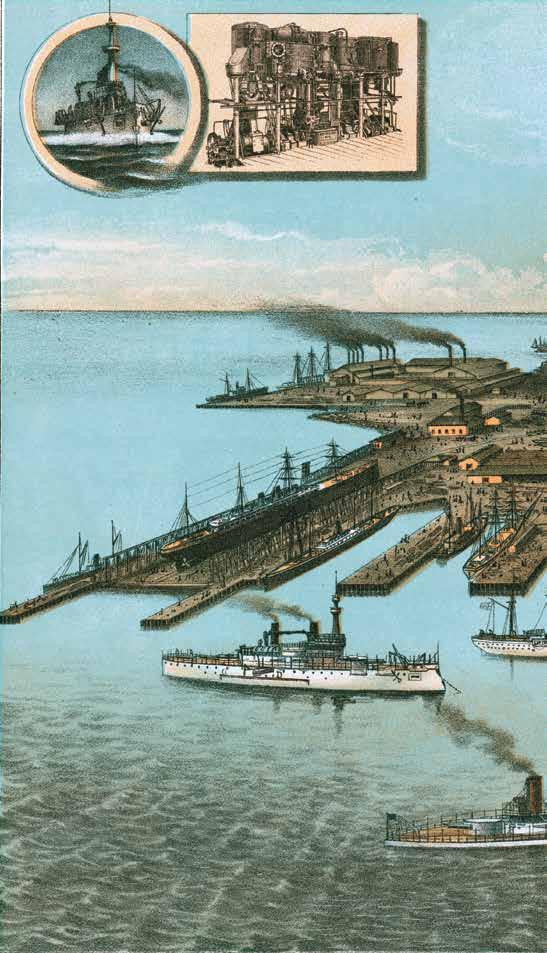

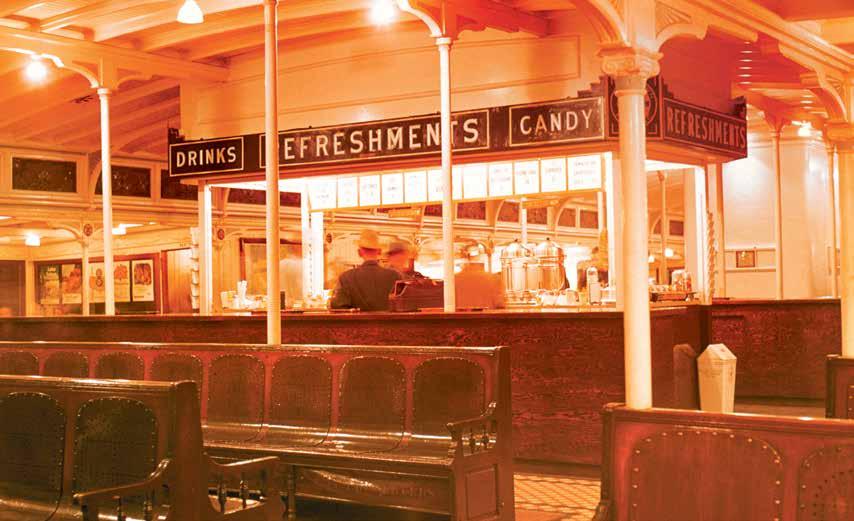
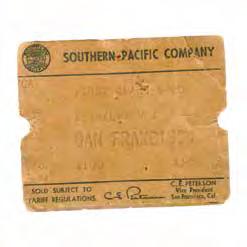

near the end of her San Francisco Bay career. The ticket was issued on her very last trip in 1958. Below, she waits to make the crossing to San Francisco. Passenger Winn Bagley recalled that “we took the Berkeley for granted—her spacious interior, her beautiful appointments and woodwork, her feeling of power and reliable schedule, her congenial crew.”
MMSD P11929, P11934
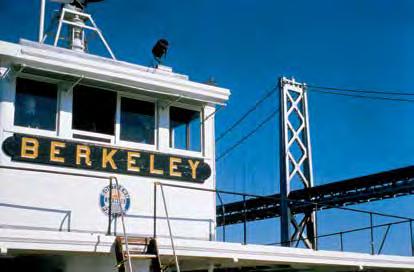
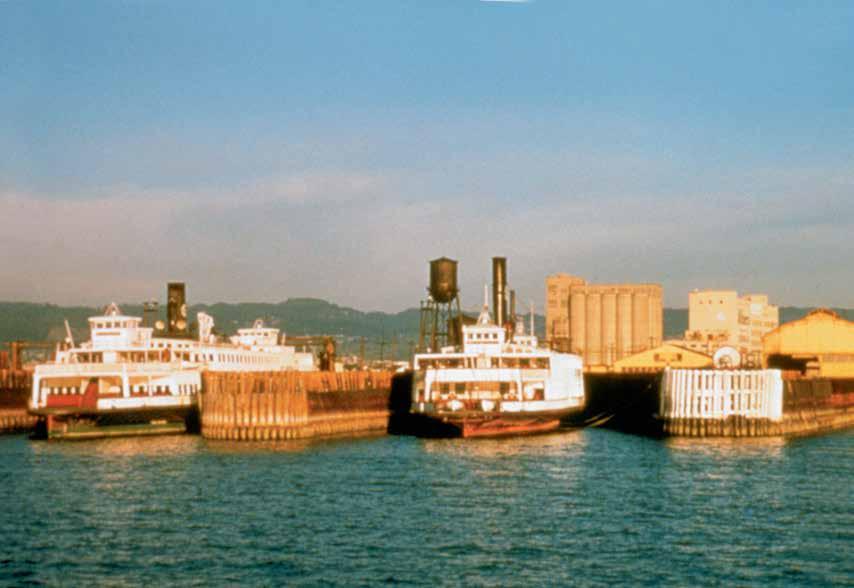

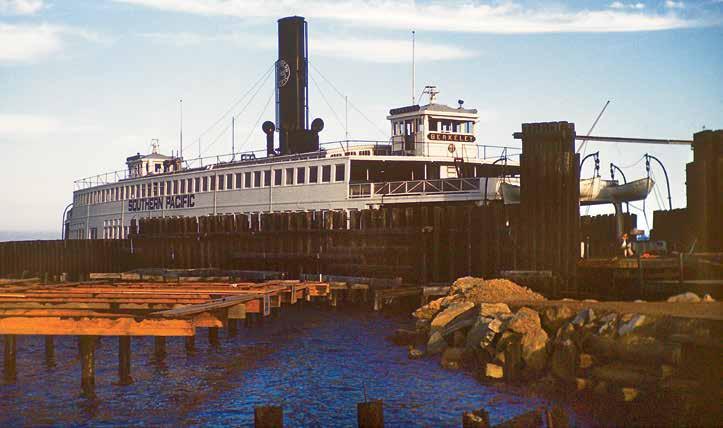
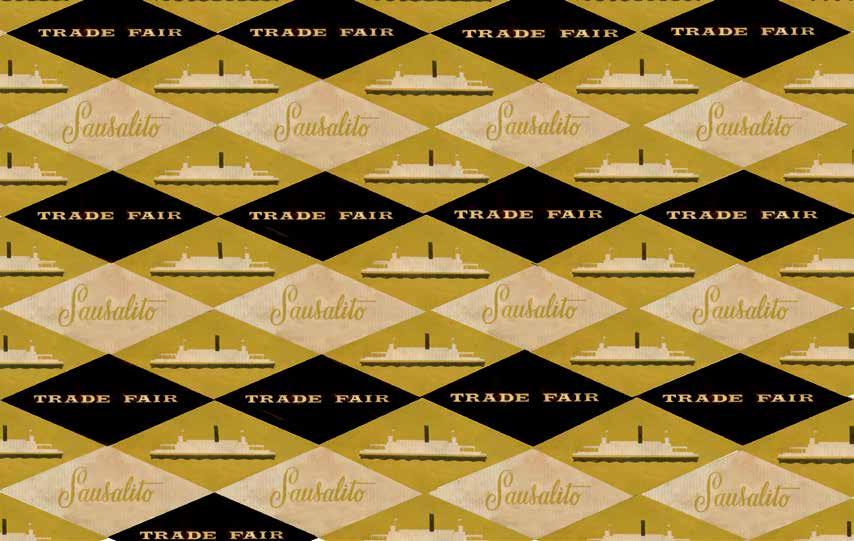
The former ferry spent fourteen years as a floating gift store on Sausalito’s waterfront, until joining the Maritime Museum of San Diego in 1973.
MMSD P13821
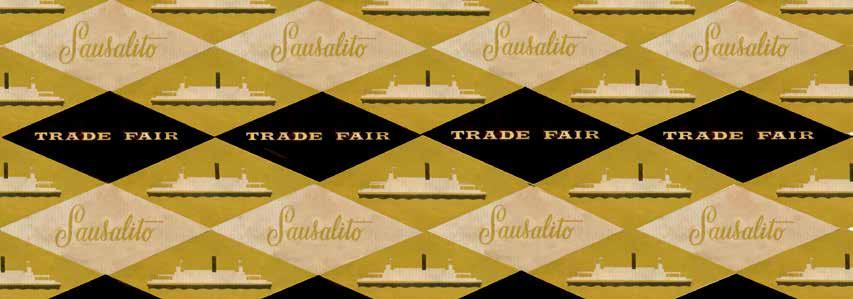


At left, Berkeley steams away from the ferry Eureka in 1956, which today is preserved at San Francisco Maritime National Historic Park. That museum’s founder, Karl Kortum, recalled that “in 1957, the Eureka was offered by the Southern Pacific to the Maritime Museum—or we could have the Berkeley. Both ferryboats were now surplus to the railroad. S.P. planned to bring San Francisco-bound passengers, disembarking from trains in Oakland, across the Bay Bridge on buses (a far less majestic arrival, it might be pointed out, but cheaper).
The Berkeley . . . was an even more elegant craft than Eureka. She retained her stained glass from the Gay Nineties. Moreover, Berkeley had a steel hull, easy to maintain in any shipyard in the age of welding. In contrast, the Eureka’s hull . . . was wood. I realized that sometime in the future, if shipwrights who worked in wood started to become extinct, the Eureka could become a very costly vessel to keep alive.
Museum President R. Stanley Dollar, Jr. . . . told me to make a choice between the Berkeley and the Eureka . I chose the Eureka. She may have lacked a steel hull and a richly ornate passenger deck, but she had something the Berkeley lacked—a onecylinder walking-beam engine four stories high.”
MMSD P12268; Kortum quote from Sea Letter, Spring 1990
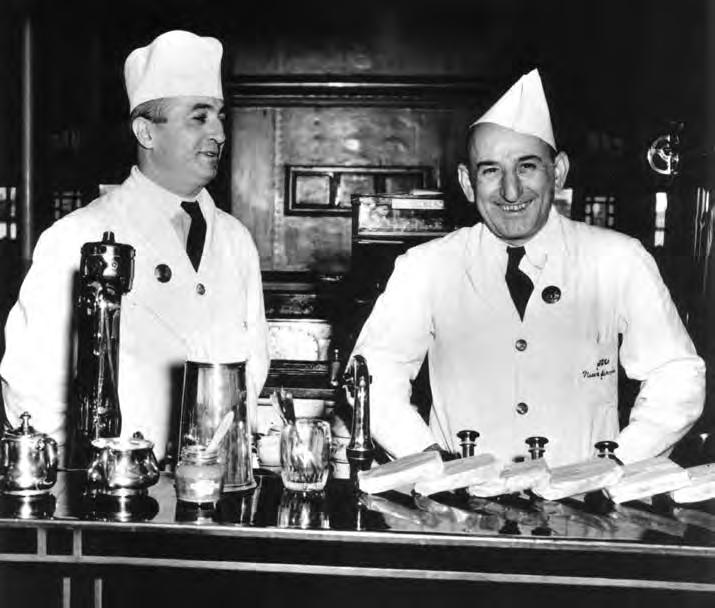
These two refreshment stand workers greeted customers aboard Berkeley about 1943. Below, the crew surrounds Captain Manuel Garcia, holding box, on his retirement in 1955. Fireman Joseph Linhares holds the lifering.
MMSD P10103; below, MMSD P3491
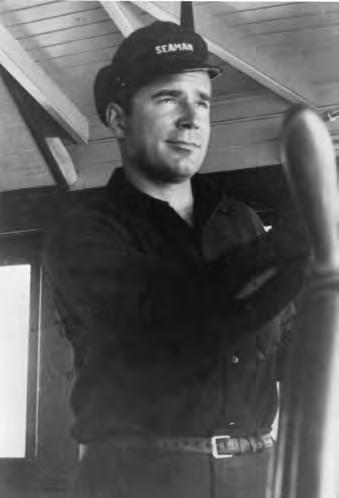
in 1951.
P9666

Powell Harrison
The combination of propellers and a triple-expansion steam engine made Berkeley revolutionary among West Coast ferryboats in 1898. The technology of the propeller was not new; in the 1840s, propeller-driven vessels began appearing throughout the world, and by 1879 a propeller-driven ferryboat plied Sydney Harbor in Australia.1 Berkeley’s powerplant, however, was truly “state of the art.” Compared to the reciprocating engines of her paddlewheel-driven contemporaries, Berkeley’s triple-expansion steam engine was far more complex, capable of operating at a much higher pressure, and vastly more reliable.
Although few of her millions of passengers ever saw

her engine room, they came to rely on its power and dependability. Berkeley was big and fast: she churned along at better than twelve knots carrying as many as 1,700 passengers plus freight, and could cross from Oakland to San Francisco in twenty minutes, making a round trip every fifty minutes, including time spent loading and unloading.2
To understand the power that drove Berkeley on the twenty trips across San Francisco Bay she averaged every day,3 we will look inside the boiler room and engine room to see how she worked, and meet a few of the men who ran her.
As gulls wheel around her, Berkeley pushes away from San Francisco around 1917. In her early appearance, the stack is slenderer, no external stairs yet reach the pilothouse, and passengers descended to the main deck down a single centrally-located staircase at each end.
Courtesy San Francisco Public Library
The steam cycle begins in the fire room, or boiler room. During her first three years, Berkeley burned coal and required a boiler room crew of one or two water tenders, who monitored water flow and levels, and four stokers, who fed three furnaces on each end of the two side-by-side boilers. In addition to maintaining the fires during their ten to twelve hour shifts (which they worked six-and-one-half days a week), the stokers also cleaned out clinkers and ash that they then manhandled topside and threw into the harbor.4 For this they earned from fifty cents to a dollar a day. Their duties included breaking larger chunks of coal down into smaller, more uniform sizes with a hammer, in order to insure adequate air circulation on the furnace grate.
The two boilers originally installed on Berkeley were double-ended fire tube, or Scotch, boilers, each nineteen feet long and almost eleven feet in diameter. Hot furnace gases were routed from each of the furnaces through separate combustion chambers, which directed the heat into the two-hundred-twenty tubes inside each boiler, each of them seven feet long by two-and-one-half-inches in diameter. The hot gases passed through the tubes and transferred heat to the water flowing around them. The steam generated in this manner was then routed to the engines. In spite of the great power generated by steam engines, their efficiency seldom exceeded eighteen percent, for most of the heat generated in the furnace went up the smokestack.
In 1901, Southern Pacific changed Berkeley’s plant from burning coal to bunker C crude oil, and installed four 2,138-gallon fuel tanks in the former coal bunkers.5 This change of fuel reduced the boiler room crew to a water tender and two firemen on each shift.6 Taking on liquid fuel was also quicker, simpler, and cleaner than lading coal, and left no ashes to throw into the bay.

In 1924, four Babcock and Wilcox water-tube express-type boilers replaced

Inside Union Iron Works’ shop before installation, Berkeley’s engine towers 16 feet from the shaft to the top of the cylinder head. The diagram at left appeared in Marine Engineering magazine in 1899.
Courtesy San Francisco Maritime NHP
A triple-expansion engine has three cylinders of graduated sizes. Steam enters the high-pressure cylinder, the first and smallest of the three, with a force that pushes the piston from one end of the cylinder to the other, a distance referred to as the stroke. As it “works” to move the piston, the steam expands and loses some of its heat and pressure. Once the piston stroke is completed, the steam is exhausted into the intermediate-pressure cylinder, the second, medium-sized, cylinder. Here the process is repeated: the steam expands further and loses more heat and pressure. The same steam is then exhausted into the low-pressure cylinder, the largest of the three, where it once again forces the piston through its stroke.
In order for this engine to power the propeller smoothly, however, each cylinder must produce exactly the same force as the others. The wide difference in steam pressure among the three cylinders is “evened out” by sequentially increasing the size of the cylinders to precisely correspond to the decreasing pressure.
A simplified example illustrates the basic mathematical concept that allows Berkeley’s tripleexpansion engine to run smoothly:
Imagine that steam under one hundred pounds per square inch (psi) of pressure is entering an engine that has a one-square-inch high-pressure cylinder, a two-square-inch intermediate-pressure cylinder, and a four-square inch low-pressure cylinder. When this steam pushes into the highpressure cylinder, it exerts its one hundred psi against that one square inch of piston surface, producing one hundred pounds of force. In the process of doing this work, the steam expends some of its heat and energy as it cools and expands. (For simplicity’s sake, let’s say that half of its energy is lost.) This means that the steam entering the intermediate-pressure cylinder now exerts fifty psi onto the two square inches of piston surface; fifty psi multiplied by two square inches again equals one hundred pounds of force. If half the steam’s energy and pressure is lost in the process, twenty-five psi remains when it enters the four-square-inch lowpressure cylinder. There, twenty-five psi multiplied by four square inches of surface area produces the same hundred pounds of force. Thus, a single burst of steam from the boiler produces the same amount of force in all three cylinders, pushing the vessel smoothly through the water.
the two Scotch boilers. Using a different principle than their predecessors, each boiler contains a bank of tubes passing across the top of a bricklined firebox. Heat was transferred as it passed around these water-filled tubes, nearly four hundred in each boiler, which terminate atop the furnace in a steam drum where the steam itself was generated.7 Sediments and impurities settled in the mud drum at the bottom of the furnace where they were discharged overboard. The lighter Babcock & Wilcox system produced steam more quickly than the Scotch boilers had.8
A water tender still patiently oversaw water flow and the water level in the four-hundred-gallon fresh water tank. After doing its work in the main and auxiliary engines, the steam was recycled and condensed back into feed water, thus eliminating the necessity of carrying large quantities of fresh boiler water. (Though the ferry was always surrounded by water, sea water’s salt and mineral content would quickly reduce a boiler and engine to a rusty mass if used as feed water.)
Closed seawater cooling tubes run through the condenser and back over the side, a marked improvement over older systems that helped cool the condensing steam by spraying it with sea water, thus contaminating the feed water and increasing system corrosion and the buildup of scale in the boilers.9
In the boiler room, a fireman oversaw all steam generating equipment and the piping, joints, and seals that handled live steam. He and the engineer were the principal men in charge of maintenance and repair on the steamer.
The principle that steam continually expands and cools until it reaches the pressure and temperature of the surrounding atmosphere was the principle that drove Berkeley’s triple-expansion engine. From the boiler, steam roared through high-pressure piping, through the throttle and the steam chest (a regulating cylinder or chamber), and entered the first, and smallest, of the three cylinders. Berkeley’s engine is double acting; its pistons, in other words, were pushed from both sides, unlike a car’s engine in which pistons are pushed from one side only. Steam jetted into alternating ends of the cylinder with each half-revolution, entering through a flat, box-like “D-slide valve” or “piston slide valve” that moved back and forth over three ports—two inlet ports and one exhaust port.10 As the
valve slid, it admitted steam to the operating side of the piston, and simultaneously closed the opposite side’s inlet and opened its exhaust. As the engine turned, the ports alternated, which pushed the piston in each direction of its stroke. These slide valves were opened and closed by a set of rods that were prodded up or down by eccentric collars on the propeller shaft. The exhaust steam from the first cylinder discharged into the second, or intermediate, cylinder, and from there into the third and largest cylinder. Spent steam exhausted from this low-pressure cylinder, was run through the condenser, cooled, and returned to the boiler as feed water.
Berkeley’s main engine cylinders are twenty-two, thirty-four, and fifty-six inches in diameter, respectively, and each has a three-foot stroke.11 In the high, intermediate, and low-pressure cylinders, steam pressures were 165, 105-110, and 30 psi, respectively. Under full speed, the engine’s sturdy piston rods drove the single shaft and both eight-foot propellers simultaneously at 125 revolutions per minute, with a rating of 1,450 horsepower.12 Stephenson links, a reversing system, allowed the engineer to change the engine’s direction by throwing two levers. One lever, the throttle, stopped the flow of steam. The other shifted a quadrant containing the rods that controlled the timing of the steam entering the cylinder, sending steam to the opposite side of the pistons when the throttle was opened again, and reversing the rotation of the propellers. The entire reversing process took ten seconds or less to complete.
Brass oil reservoirs containing wool wicking lubricated stationary bearings, while bearings on rods were lubricated by oil constantly dripping from cone-shaped brass cups; tubes carried it to connecting rods and other moving parts. Since the bearings lacked heat sensors or thermometers, the fireman or engineer frequently “slapped the bearings” to monitor their temperatures by leaning over alongside the spinning crankshaft and touching them. One engineer compared checking the bearings in this way to wetting one’s finger before testing the temperature of a clothes iron—the difference, of course, being that no hot iron is turning at 125 rpm.13
The engine room crew consisted of an oiler who kept moving parts lubricated and the oil reservoirs filled, a wiper who answered all bells on the engine order telegraph, wrote the rough log and kept the engine room tidy, and a first- or second-assistant engineer who was Engineer of the Watch, supervising the engine room and operating the main engine. The Chief Engineer on board was responsible for the entire engineering operation and crew. The Port Engineer, stationed at the ferry terminal, oversaw the entire ferry system,
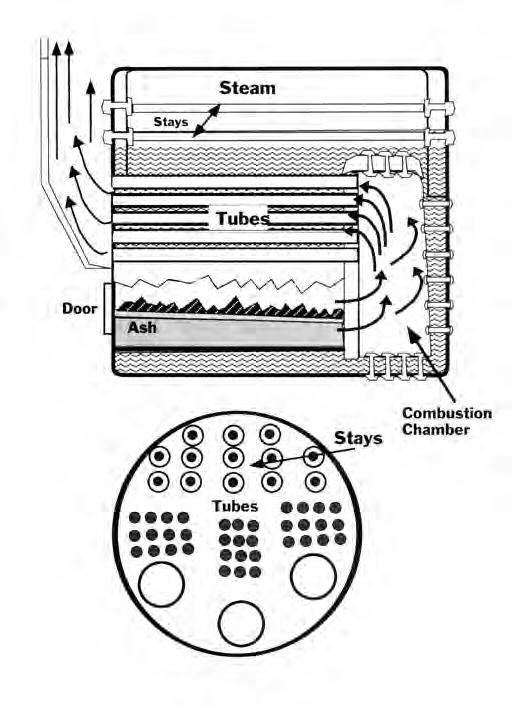

The energy stored in all types of fuels, whether wood, coal, petroleum, or uranium, is transferred to a steam engine via water, which becomes steam when heated. Once the steam has done its work in an engine, it escapes either to the atmosphere or to a condenser. In a condenser, residual heat is removed from the steam by cooling the vapor and returning it to its liquid state.
The condensate pump then pumps the water into a “hot well” where filters remove impurities like oil and dirt. The feedwater pump then pumps the clean water back into the boiler, where it is heated once again to become steam.
For Chief Engineer Rae Barnett, right, “no ferry could ever match the Berkeley; she remained his favorite until his last day of work,” when he had a heart attack in her engine room in 1945. “One of the incalculable joys I experienced,” his son Earl recalled of visiting the engine room as a boy, “was when my father would call out, ‘Okay, take her out.’ I got so I could handle her pretty well. Of course, this was our little secret, but no one ever betrayed us.”
MMSD P9679; enunciator photo by John Wright

Condensing steam conserves precious fresh water. If sea water, with its mineral and salt content, were used as feedwater in a boiler, it would soon corrode boiler and engines alike into a rusty mass. Therefore, only fresh water is used in most boilers, and by condensing steam back into water, ships need to take on fresh water less often.
Also, the greater the difference between the inlet pressure (where steam enters an engine) and the outlet pressure (where it exits), the more energy can be extracted from the steam. By condensing steam, which occupies as much as 1,600 times the volume that water does, a vacuum is created, and the difference in pressure between the inlet and outlet is increased, thus extracting more work from the steam.
trotting from one ship to another, checking his crews’ work, and occasionally pulling an ailing ferry off the line.
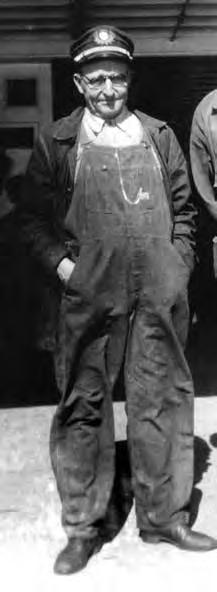
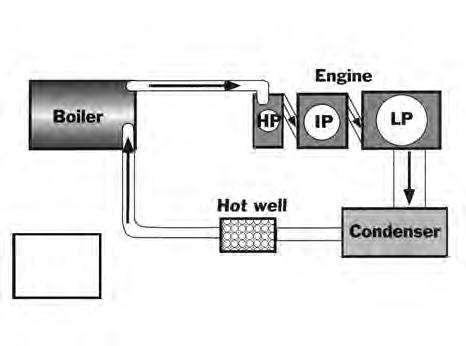
Orders for engine speed and direction, or “bells,” were received from the Captain in his pilothouse on the engine order telegraph, on which an arrow on the face of the clock-like enunciator pointed to the correct order: AHEAD FULL, AHEAD HALF, AHEAD SLOW, STAND BY, STOP, FINISHED WITH ENGINES, BACK SLOW, BACK HALF, or BACK FULL. The wiper confirmed that the orders had been heard by moving a handle on the engine room telegraph, which in turn moved an arrow on the enunciator in the pilothouse to match the position at which the Captain had set the handle. The Engineer of the Watch then executed the order. The Captain could also confirm engine actions by putting his ear to a voice tube configured to allow him to hear whether the main engine was running, or by consulting an indicator connected to the propeller shaft that spun an arrow in the pilothouse indicating the direction in which the propeller was turning. Although the engine order telegraph was the main means of communication between engine room and pilothouse, verbal communication was also possible by shouting through a voice tube to each wheelhouse.
In the early 1920s, as a boy in Berkeley’s engine room visiting his father, Chief Engineer Rae P. Barnett, Earl Barnett was startled by a “strange” clamor of bells from the engine order telegraph. His father
had just finished making a landing. We had just received the “Finished with Engine” signal and started walking away when the telegraph started banging recklessly like it was going out of control. I was startled. I looked at my father and exclaimed, “What was that all about?” He turned to me and, with that quiet smile I knew so well, explained, “It’s [Captain] Plumgren’s way of saying thank you for a job well done.”14
Steam also drove an array of auxiliary equipment, including Berkeley’s primary electric plant. This vertical compound engine15 powered a generator and four hundred incandescent lights, while a secondary unit powered one hundred lights for daytime service. Electric light bulbs had been installed on ferries for a decade before Berkeley was launched, but prior to 1910 the steam pressure to
Berkeley’s electric plants fluctuated frequently, causing the lights to dim, flicker, and flare.16 The problem was solved by installing a twenty-five kilowatt steam-turbine generator operating at a constant 150 psi, mounted in front of the engineer’s desk in the engine room, plus a fifteen-kilowatt steam reciprocating generator mounted amidships just above on the main deck, aft of the engine casing. Both systems produced direct current.
The Berkeley was steered with help from a steam-driven worm gear located on the main deck, directly below each pilothouse. This turned a grooved drum, around which a chain is wrapped; the chain connects to steel rods running the length of the ship. As the pilothouse wheel was turned, these rods pulled right or left on a steel arc, or quadrant, atop the rudder at the opposite end.

Once Berkeley was moored in the slip, the Captain put his rudder amidships. He then pushed a doorbell-like button to order a deckhand to drop a four-inch diameter pintle into the rudder, to lock it into place. The pintle would then be removed from the rudder closest to the slip, the Captain would walk to the opposite pilothouse, and Berkeley would begin her return trip across the Bay.
All auxiliary equipment—the bilge pumps, whistle, freshwater pumps, boiler feed pumps, condensate pumps, seawater cooling pumps, lube oil service pumps, ventilation, fuel oil heaters and pumps, generators, air compressors, fire pumps, steering engine, and both electrical generators—were run by steam. At the turn of the twentieth century, steam reigned supreme as the proven power source, while electricity remained a distant second and internal combustion engines were just coming into their own.
Also thanks to steam, passengers and crew enjoyed cool or warm air in the saloon deck, eating areas, and crew spaces. A “squirrel-cage” blower—a
Chief Engineer Lawrence Bulmore, Oiler Herb Kenyon, and First Assistant Engineer Lloyd Price pose by the telegraph in May, 1954. To a child, these men were heroes inhabiting a fabulous realm: “As a lad of five, I was completely dazzled that night by what surrounded me in that mysterious world of an old reliable, triple-expansion steam engine. I can remember a maze of lights; how hot it was; how shiny all those bronze clock-like gauges were; the hissing of feed pumps; the friendly faces of the crew smiling at me; and how I reacted in fear when suddenly a loud, clear ‘clang, clang’ boomed from the telegraph. I looked up just in time to see that little arrow move back and forth until it rested on FULL AHEAD,” recalled the son of Engineer Rae Barnett.
MMSD P3749

Courtesy John Wright

MMSD P2028
motor turning a wheel resembling a hamster excercise wheel—driven by its own dedicated compound engine, drew air from an intake below the ferry’s apron, into an engine room duct, and then sent it upwards. A network of ducts, hidden inside structural members supporting the upper decks, delivered fresh air to a column at the end of each outboard set of seats on the upper deck. Brass registers at the tops and bottoms of those columns could be adjusted manually for airflow. Ducting delivered air to other spaces, including the restaurant and crew compartment. In cool weather, the fireman or engineer would open a set of steam coils in the uptakes to heat incoming air to a more comfortable temperature.17
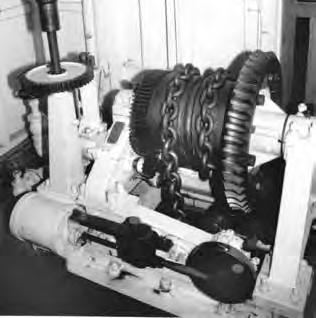
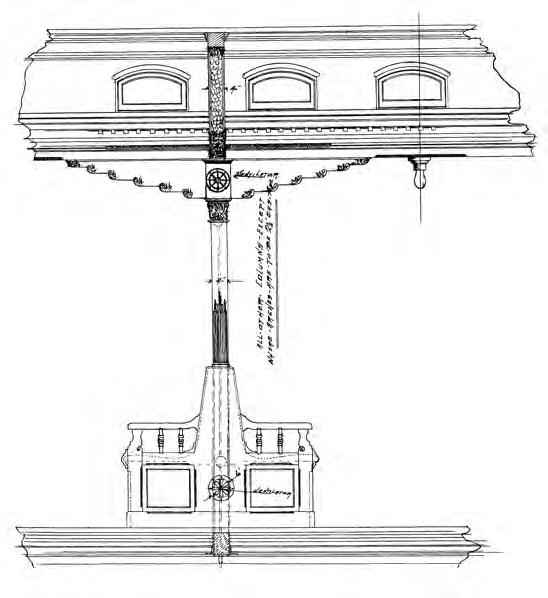
Over a century after she was launched, Berkeley’s engine room remains intact and transports visitors to an earlier time. The engine today still “runs” for the benefit of visitors, thanks to an ingenious hydraulic system created by museum volunteer Ed Paxton. Most of the engine room’s auxiliary equipment runs as well, using compressed air from two compressors installed in the after fuel bunker. Paxton’s foresight, and the efforts of countless dedicated volunteers, allows engineers, aspiring engineers, and the curious to contemplate the power plant that Berkeley passengers always relied on but seldom saw or understood.
1 Richard E. Brown to Harry Cotterell, 22 September 1975, Brown Collection, MacMullen Library and Research Archives, Maritime Museum of San Diego (hereinafter MMSD).
2 In acceptance trials, Berkeley was clocked at 13.66 knots. “Double Screw Ferryboat Berkeley at San Francisco,” Naval and Marine Engineering Journal 4 (August 1899): 53.
3 The figure of 20 trips per day represents her average in the mid-1950s. (M. T. Austin to Chester R. MacPhee, 2 February 1954, copy at MMSD.) Her average number of daily trips in earlier years was likely similar.
4 A clinker is a hard, partially vitrified mass that forms when coal containing impurities is burned in a furnace.
5 Engineering drawing, “General Arrangement, Tanks and Oil Pipes, SP Co Stmr Berkeley West Oakland Nov 11, 1901,” copy in plan collection, MMSD. This does not appear to be a Union Iron Works plan, but may have been prepared elsewhere to guide her later modifications.
6 Although firemen replaced stokers, many duties and responsibilities remained the same. The main difference between the two jobs was that stokers had to shovel coal into the furnaces while firemen regulated the flow of oil into the furnace’s firebox.
7 Tubes 4” in diameter make up the lower rank in the boiler, while the remaining ranks are composed of tubes 2” in diameter. All are installed at a 10 degree angle, which increased efficiency and helped direct impurities toward the bottom, where the ends could be removed for cleaning. Oil left a coating of soot on the tubes exposed to the flames, which caused inefficient heat transfer. In the Scotch boiler, this required “punching out” the tubes with a wire-bristled brush, or with rotary tube cleaners, during a maintenance stand-down. In the later water-tube boilers, tubes were “blown” at least once a day, using a steam lance made of piping, inserted into the tube nest and played on the surface of the tubes. This usually caused soot to issue from the smokestack, soiling everything beneath.
8 Robin E. Sheret, Smoke Ash and Steam: West Coast Steam Engines (Victoria, B.C.: Western Isles Cruise and Dive Co., Ltd., 1997), 35; San Francisco Chronicle, 4 December 1926.
9 Alan Osbourne, Modern Marine Engineer’s Manual, (New York: Cornell Maritime Press, 1941), 13; George Harlan, San Francisco Bay Ferryboats, (Berkeley: Howell-North Books, 1967), 81.
10 Although D-valves and piston-valves have different configurations, both are forms of slide valves. Berkeley’s cylinders contain both types. The first cylinder
By the time this photo was taken on her way to Oakland in 1914, the superiority of Berkeley’s engine and propellers were proven. In an echo of her predecessors, however, the words “Southern Pacific” painted on her side match the curve of a paddlewheel box.
Courtesy San Francisco Maritime NHP, B7.1109
uses a piston-valve, while the second and third cylinders employ D-valves. Eccentrics are discs similar to cams mounted off-center on a crankshaft upon which shafts are strapped in such a manner as to translate the rotary action of the crank shaft into the reciprocating motion needed to operate the timing mechanism.
11 A three-foot stroke refers to the distance the steam moved the piston, in this case 36”.
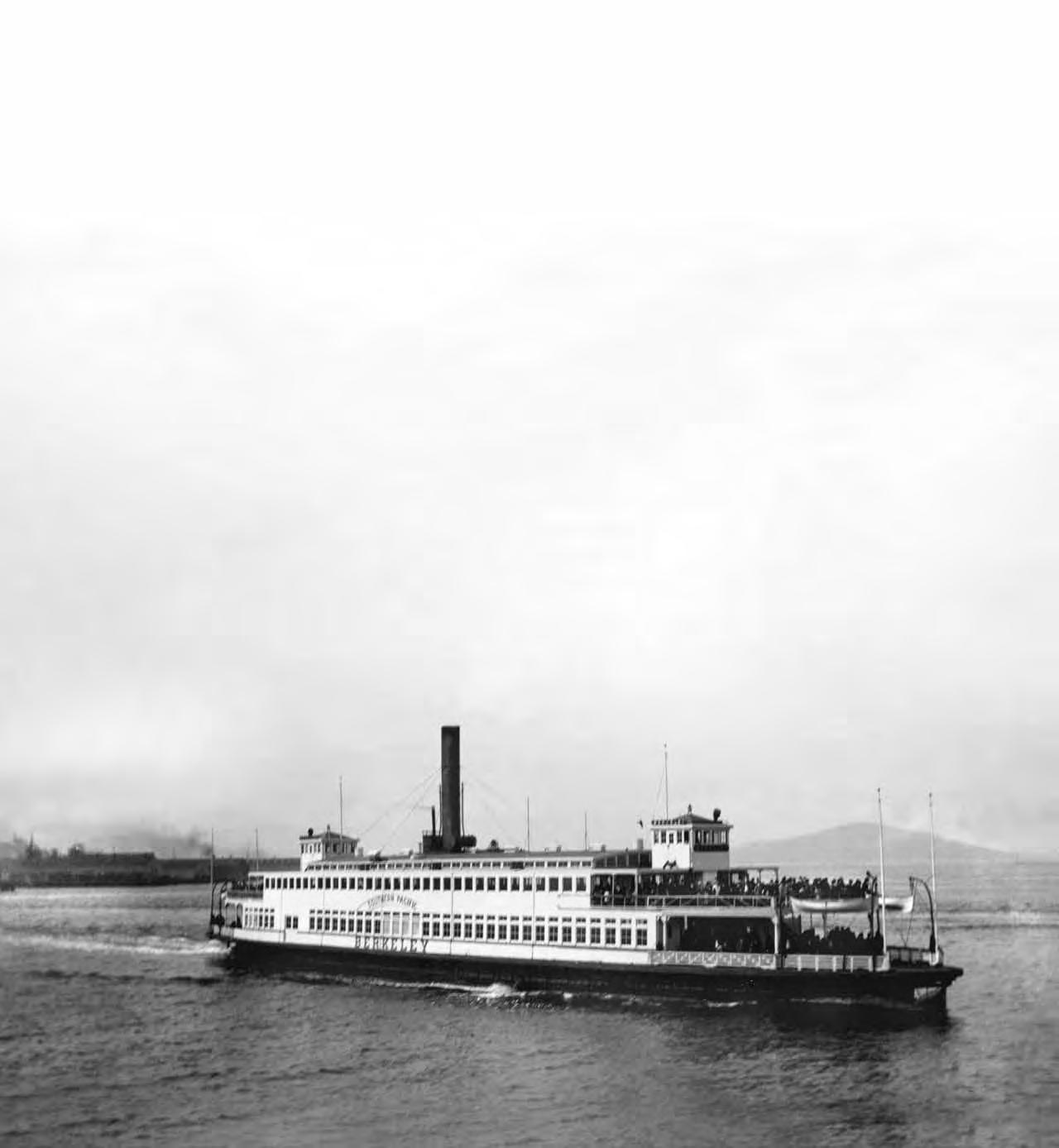
12 “Double Screw Ferryboat Berkeley,” 54-55. “Rated” horsepower is the measure of work or power expected, based on design calculations. “Indicated” horsepower is observed in underway trials, and may be more or less than the rated horsepower. Berkeley’s mean indicated horsepower was 1163.66, while her rated horsepower was 1,450. C. E. Ward, a Southern Pacific vice president, stated that Berkeley “produced 1,125 horsepower.” Ward to C. Ray Wilmore, 1 February 1973, MMSD.
13 Winn Bagley, oral history interview, 11 July 1998, MMSD.
14 Earl Barnett, “My Father and the Berkeley,” Mains’l Haul 28 (Summer 1992): 5-6.
15 A compound engine operates on two cylinders. After the invention of the triple-expansion engine, these were used mainly to power smaller vessels and auxiliaries using relatively low pressure. This compound engine’s two cylinders feature 7 1/2” and 13 1/2” cylinders, with a 6” stroke.
16 A single-sheet description of Berkeley ’s equipment at MMSD, handwritten after 1910, suggests that both generators were replaced in September 1910.
17 “Double Screw Ferryboat Berkeley,” 54.
Mellissa Eddy

PASSENGERS
San Francisco Bay was not without its perils: fog, storms, congested vessel traffic, strong currents and unexpected obstacles sometimes afflicted Berkeley and the other ferryboats. The experiences of Berkeley were typical of ferries on the Bay. Most crossings were uneventful, but occasionally debris floated into her path, or the high volume of traffic and bad weather conditions resulted in a collision. In addition to these typical experiences, however, an explosion aboard her in 1911 has left an enduring aura of mystery.
Collisions between ferries and debris on the Bay occurred regularly, often requiring repair work. According to Berkeley’s wreck reports, “submerged objects” damaged her propellers and rudders at least nine times.1 Concern over debris and the destruction it caused was not restricted to ferryboat captains and owners. In 1914 the San Francisco Examiner informed readers that
floating debris drifts to and fro within and without the pier slips as regularly as the tide, according to the launchmen who are preparing to protest to the Board of State Harbor Commissioners. The launchmen hope that, by bringing the attention of the State officials to the evil, steps will be taken to force the contractors to hold fast to the numerous old piles and timbers instead of permitting them to float away upon the tide and menace the craft of the launchmen,2
and the propellers of ferries like Berkeley

Collisions between vessels were more dramatic, if less frequent. On the evening of April 5, 1911, the ferry Bay City departed Alameda at 6:35 for San Francisco. Five minutes later, Berkeley steamed away from the San Francisco ferry terminal bound for Oakland. Shortly before seven,
several hundred transbay passengers were thrown into a panic . . . when the ferry steamers Berkeley and Bay City of the Southern Pacific Line crashed in midstream near Yerba Buena Island . . . None of the passengers had warning of the collision, and immediately after the two steamers crashed together there was a wild rush for life preservers. Women screamed hysterically, and the crews of the vessels had difficulty restoring order.3
Since the Berkeley suffered minimal damage, she returned to her regular run, while Bay City’s smashed rudder kept her out of service for several days. According to the news report, “just a bit sharper angle and just a little heavier impact, and both probably would have gone to the bottom of the bay.” After a preliminary investigation, Southern Pacific officials found Captain Alfred Rogers of Bay City at fault.4
Berkeley and the ill-fated San Rafael cross paths as they near San Francisco around 1899. San Rafael collided in fog with the ferry Sausalito and sank with the loss of several lives on November 30, 1901.
MMSD P8314
Mellissa Eddy, who earned a graduate degree in history at the University of San Diego, was an intern and volunteer at the Maritime Museum of San Diego.
Debris from a smashed slip and lifeboat litter Berkeley ’s deck following a collision with a ferry slip, probably in the late 1930s.
MMSD P11719

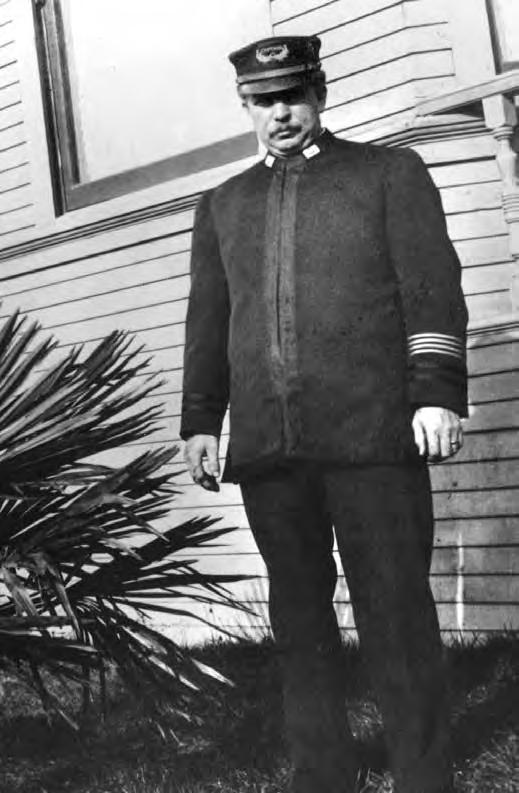
The notorious fogs could make the daily commute hazardous. On one December night in 1908, “the kind of night,” according to a ferry captain, with fog “as thick as mush, low down over the water,” the waterfront lights remained obscured to the captains’ views until the ferries came within a hundred yards, forcing them to rely almost exclusively upon the sound of bells and whistles to navigate. According to the newspapers, ferry service was carried on that night “only with great risk of accident.”5
Berkeley’s Captain E. A. Johnson fell off his course, and crashed into the pilings of the main slip at Oakland. Southern Pacific superintendent William MacKenzie explained the cause:
Allowing for the flood tide, Captain Johnson turned the boat to the north, expecting to float in on the tide as usual. He misjudged the distance and swung his boat too far to the north. I should judge about ten feet. As a result, the forward end of the Berkeley struck solidly against the nose of the pier.6
The collision shattered pilings twelve inches in diameter, tore away a portion of Berkeley’s starboard side, ripped off her railing back to the lower cabin, sheared away the iron lifeboat davits at deck level, and destroyed the starboard lifeboat. Wreckage covered the partly demolished forward stairs to the upper deck. Southern Pacific’s Assistant Superintendent of ferries, J. G. Camp, tried his best to minimize the incident, stating that “the impact was not very heavy, but owing to the softness of the pier timbers greater damage was caused than would have been possible under other conditions.” 7
Passengers, eager to disembark and run for the waiting trains, were crowded on the lower deck when the south end of the slip suddenly emerged from the dense fog. Panicked passengers scrambled for the cabin doors and safety. “Shrieking women ran toward the stern of the vessel and only the prompt action of the crew and a few level-headed men prevented several passengers from jumping from the stern deck into the bay.” As a result of flying timbers and the falling lifeboat, five passengers were injured, one of whom, Miss Kate Crowley, later died. The panic ceased only after some level-headed individuals shouted that the ferry was at the slip, and therefore would not sink.8
MMSD P11716
The Berkeley’s most infamous incident was an explosion on January 13, 1911. During a routine early evening crossing, at 5:55 P.M. Captain John T. Jones glanced at the lighthouse on Goat Island. In the next moment, the needle of the compass shook, the vessel rocked, and the pilothouse windows shattered. Captain Jones heard a dull noise, saw a flash and, assuming that the boilers had exploded, immediately
telephoned down to Chief Engineer James Peacock to find out if there was any trouble in the engine room. He replied that there was not, and then [Jones] dispatched First Mate E. N. Johnson to ascertain what was wrong. As there was nothing the matter with the ferryboat [he] continued for the pier at full speed.9
There was wild panic among the capacity crowd of commuters. The passengers evidently believed that an explosion had occurred in the engine room, and for several moments the great crowds on both decks were in mad disorder. The officers and deckhands quickly assured them that nothing was wrong with the boat, although there was still great excitement when they disembarked.
In the midst of the ship-wide panic, crew members quickly determined that the explosion had come from the men’s lavatory, which was located downstairs from the main deck, adjacent to the bar.10 A Norwegian-born mining engineer, John
O. Norbom, owner of the Maddox mine in Shasta County, apparently boarded Berkeley with a vial of nitroglycerin in his pocket.11 An explosives expert later theorized that the nitroglycerin
was carried in the man’s overcoat pocket, and that when he threw his coat back in the lavatory it exploded from contact with the tiling on the sides of the room. Two facts seem to bear out this theory. One is that the explosion took place several feet from the ground because the flooring of the place was intact. The other is that the man was disemboweled from the back, showing the explosion came from behind. His face and the front portion of his anatomy were intact.12
One of the witnesses described a blast
like that of a cannon. The door of the compartment burst out in a hundred pieces and a great cloud of white smoke poured from the interior of the room. When this cleared away I saw the mangled corpse lying in the doorway. One of the injured was evidently leaving the room as the explosion occurred and was struck by the bleeding corpse, which was hurled across the lavatory, striking the doorway.13
Norbom died instantly, and five men were injured. A passenger named Hoffschneider, deafened by the explosion, suffered fractured ribs, lacerations, internal injuries, and a concussion. Royal Sampson’s right arm was badly lacerated and broken in several places, “partly by the weight of the body that fell on him and partly by the force of the explosion.”14 By chance, among the bystanders cut and bruised by the hail of wood splinters and debris was an extraordinary West Coast maritime figure: longtime whaling captain William T. Shorey of Oakland, the first African-American to be appointed ship’s captain on the Pacific Coast.15
While most agreed with the coroner’s jury that the explosion was an accident, some believed it a suicide, and John Norbom’s family remained convinced that he had been murdered. His wife related that three days earlier, he had mentioned feeling “hunted” again, as he believed he had been in 1908 when he claimed to have been followed around Europe by someone intent on killing him. He believed that once again, assassins had mistaken him for someone else.16
Berkeley soldiered on, however, and, except for that one extraordinary explosion, the ferry that had been so accident-prone in her early years overcame her reputation as the “pile driver’s friend” to become a safe and familiar part of the Bay’s ferry service until 1958.
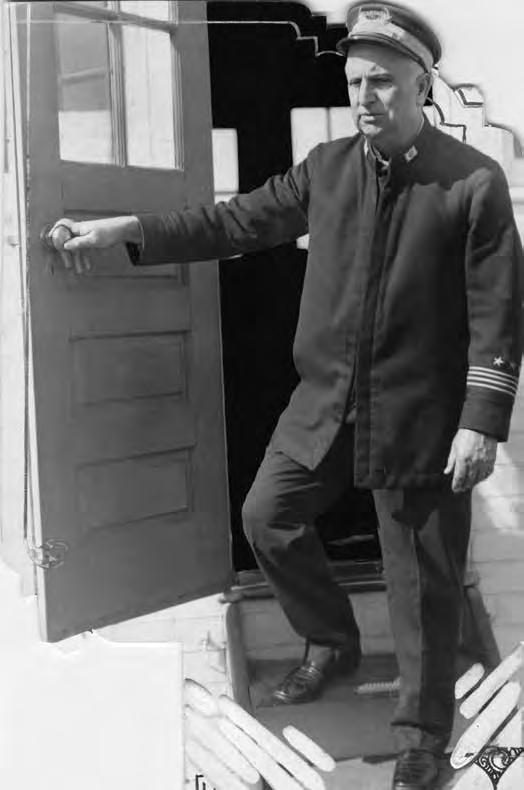
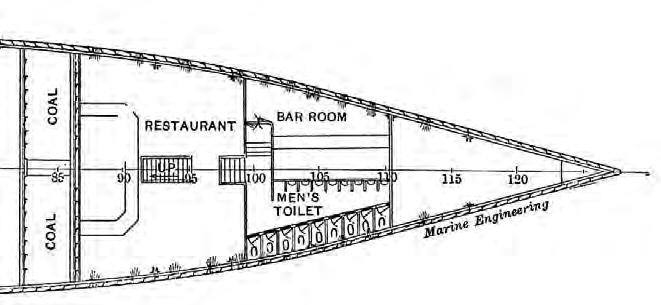
Dear Mother, They nearly had a collision on the Bay near the Ferry the other day between the Bay City and the Berkeley... With Love to all, Laura
from a 1907 postcard, MMSD PC1222
1 Wreck Reports, Ferry “Berkeley,” Record Group 36, Records of the United States Customs Service, National Archives and Records Administration, San Francisco. Wreck reports record 24 of these incidents during her first 37 year of service. At least one collision with a ferry slip that did not appear in these reports, however, received extensive coverage in San Francisco newspapers. It is reasonable, therefore, to assume wreck reports missed other incidents during those years.
2 San Francisco Examiner (hereinafter Examiner), 3 December 1914.
3 Examiner, 6 April 1911.
4 Both ferries were taken to Oakland Creek for damage assessment and repairs. The stanchions on Berkeley’s starboard side were bent, and Bay City’s front rudder and boat davits were torn away. Examiner, 7 April 1911.
5 Examiner, 7 December 1908. Johnson, charged with negligence, was exonerated. Undated clipping, cMullen Library, Maritime Museum of San Diego.
6 Examiner, 7 December 1908.
7 Ibid.
8 Ibid. Roughly four hours after Berkeley rammed the Oakand pier pilings, Southern Pacific ferries Oakland and Newark collided. Both suffered damage but made port without assistance. Except for cases of shock and extreme nervousness, the passengers were virtually unharmed. That same fogbound evening, two Key System ferries nearly rammed each other.
9 San Francisco Chronicle (hereinafter Chronicle), 14 January 1911.
10 The men’s lavatory was located on the starboard side of what is today the Gould Eddy Gallery of the Maritime Museum of San Diego.
11 San Francisco Call, 22 January 1911.
12 Report to Southern Pacific by Dr. Harry East Miller, quoted in Oakland Tribune, 14 January 1911.
13 State Railroad policeman James King, quoted in Chronicle, 14 January 1911.
14 Ibid. See also Oakland Tribune, San Francisco Call, and Chronicle, 14 January 1911. Newspaper accounts vary slightly: Hoffschneider’s first name was either Edward, Edwin, or Edmund, and Royal Sampson was either a doctor or a laborer in the employ of the Oakland Board of Health.
15 A. C. Miller and Louis Faure were the other injured passengers. On Captain Shorey, see Daphne Lagios, “Bold Lines Connect: The Shoreys, A Unique Maritime Family,” Mains’l Haul 34 (Winter 1998): 28-35.
16 Chronicle, 14 January 1911. Norbom’s family doubted his death was accidental partly since “he was not in the habit of carrying explosives around with him, that he had no use for anything except giant powder, and that he had a great fear of explosives.” Son-in-law Olaf Bals, superintendent of Norbom’s Maddox Mines, explained that Norbom “never ordered explosives used by us at the mine. I attended to that myself. The trips which he made to this city and San Francisco were to visit his family and of making a few business arrangements.” (Oakland Tribune, 16 January 1911.) According to Norbom’s old partner, Nelson D. Phelps, “never to my knowledge—and I have known Norbom off and on for nearly twenty years—has he ever carried dynamite or any other explosive around with him . . . He was one of the most careful and most sane men and never did anything out of the way.” Phelps further stated that his former partner had a fear of powder of any kind. The coroner’s inquest took place 21 January 1911. (San Francisco Call, 22 January 1911.)
Long since retired from ferry service, a boarded-up Berkeley is towed beneath the Golden Gate Bridge on her way to San Diego on May 21, 1973.
MMSD P553

BERKELEY: A Pioneering West Coast Ferryboat
Diane Cooper
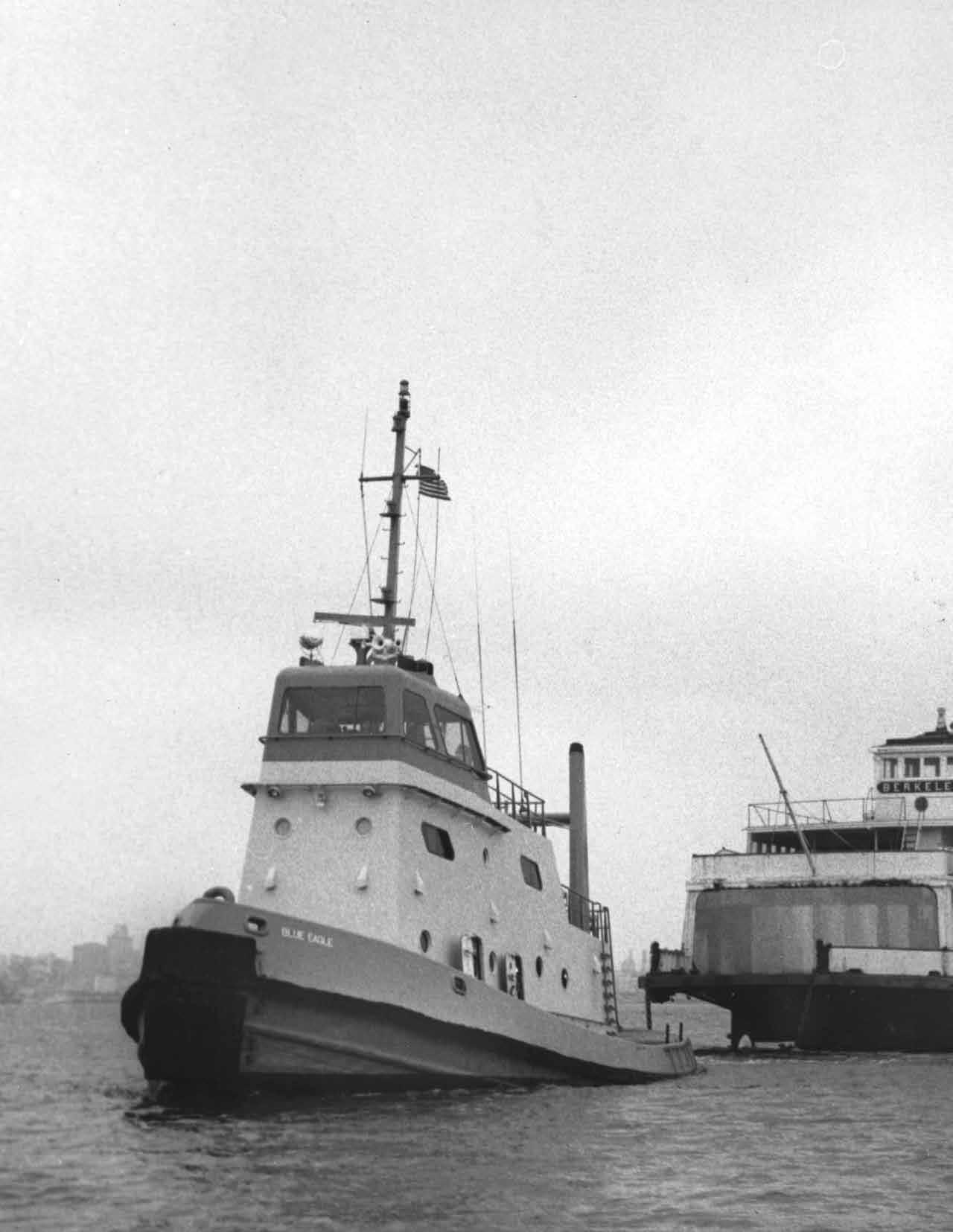
Blue Eagle tows Berkeley into San Diego Bay on June 3, 1973. Coupled with the cracked and peeling paint, the plywood protecting her windows gave the newest member of the museum’s fleet the look of an abandoned derelict.
MMSD P5513
Immediately following Berkeley’s 1973 arrival in San Diego, the museum staff began the major task of cleaning, repairing, and repainting the ferryboat. The vessel arrived looking shabby and forlorn, with protective sheets of plywood over her windows and dingy, cracked, and peeling paint covering her exterior. She had been acquired less for her historical or architectural significance than for spacious decks where the museum planned to install exhibits, house administrative offices, store artifacts, and relocate the library and store. Initially, staff “thought they could just knock off the loose stuff and paint over it,” recalled Andy Anderson, who headed the paint crew.1 After some intense discussions, however, staff agreed that merely painting over rotted wood and layers of unstable paint would ultimately increase the maintenance required and accelerate the vessel’s deterioration. Instead of being a simple paint job, Berkeley’s restoration and preservation has presented numerous challenges and required the combined efforts and skills of professional carpenters, painters, welders, electricians, engineers, and stained glass restorers, as well as the donation of tens of thousands of hours by volunteers.
Under the leadership of the Museum’s Restoration Director, Captain Ken Reynard, the museum staff developed a restoration philosophy that insured consistency of methods and results. Even though the museum was already overtaxed with the

restoration of the 1863 bark Star of India, and beginning to dream ambitious dreams of sailing her again, Reynard insisted that the work on the Star’s less-glamorous new stablemate also be more than what he derided as “paint brush restoration.” To add to the burden, the historic steam yacht Medea joined the museum’s fleet one month after Berkeley’s arrival.
One of the most pressing issues facing the museum staff was speedily getting the new facility’s doors open to the public with exhibits in place. While the curatorial department began developing displays and planning for exhibits, a four-man paint crew, welder, electrician, and three or four carpenters worked simultaneously on a variety of Berkeley restoration projects. The painters removed layers of old paint throughout the vessel, while the carpenters replaced rot-infested wood wherever they found it, and other crew members designed a new set of stairs into the engine room and welded it in place to allow workers, and later visitors, easier access to the long-hidden spaces below. At the same time, work began on the passenger deck, neglected for over a decade, which was slated to become a space available for rent by private individuals or organizations, to bring in much-needed revenue. Less than a year after they began, the museum opened Berkeley to the public while her restoration continued.
In an attempt to make Berkeley more presentable and to stabilize the superstructure before inclement weather arrived, the restoration of the exterior was one of the first jobs undertaken by the paint crew. Conditions for the men restoring the Berkeley at her “B” Street Pier mooring were far from pleasant. “The heat was intense,” recalled painter Chuck Thomas; “it must have been about a hundred degrees on the side of the ship.”2 Andy Anderson’s paint crew worked through the hot afternoons
Diane Cooper received her MA in Maritime History and Nautical Archaeology from East Carolina University. She was formerly the Maritime Museum of San Diego’s Curator of Collections and editor of Mains’l Haul, and currently resides in the Bay Area.


with “sweat from top to bottom and paint chunks stuck all over our face and back and our arms.”3
In addition to the unpleasant conditions, the work was anything but easy. Since the vessel’s extremely dry condition made her a potential fire hazard, the men worked with hand scrapers, rather than heat guns or torches, to remove accumulated layers of paint, scraping down to bare wood by hand.
The carpenters worked behind the painters on the exterior, originally planked with Port Orford cedar of such high quality that only two or three knotholes were discovered by restorers on either side of the ship. Whenever the surface prepping exposed pockets of rot, the carpenters removed the infested wood and replaced it with new tongue-and-groove planks crafted from Douglas fir.4 Between forty and sixty percent of the ferry’s sun-blasted south side required replacement.
After the removal of all rotted sections and installation of new planking, the painters returned and sanded everything until it was fair or smooth. The tongue and groove planking required meticulous cleaning and detail sanding of its seams in order to make it fair. The faired surface was sealed with a coat of oilbased primer, which needed a full day to set. The painters then caulked and filled all the seams with a vinyl latex caulking compound that had excellent adhesion and flexibility. “Boy, did the guys used to wear their fingers out, because that’s how they’d caulk it,” remembered Andy Anderson; “they’d run their finger over it to set it down into the groove and blend it . . . The guys’ fingertips would be just worn raw by the time we got done.”5 With the seams caulked, the painters applied a second full coat of primer and let it set overnight. Then they sanded the surface and applied the first of three coats of yacht enamel, which turned out to be a mistake. While the enamel “looked gorgeous, it looked like the side of a refrigerator . . . almost like porcelain,” over time the inflexible enamel became brittle and began to crack and peel.6 Within seven years, the museum switched to a more flexible acrylic latex paint as the exterior finish.
The painters followed the same basic procedures on the interior spaces. First they “wooded down” all bulkheads, bulwarks, and machinery throughout the engine room, the main deck, the lower level restaurant area, and the passenger deck. Then, after completing necessary repairs, they sanded and primed the interior before applying finish coats of marine enamel.
On the former passenger deck, however, the crew faced other problems. While berthed in Sausalito as the Trade Fair, Berkeley’s passenger deck had been closed off, and became home to numerous pigeons who littered it with excrement and feathers. Before restoration could begin, the area required a thorough cleaning. The paint crew then began “wooding down” the beautiful Victorian appointments. After decades of shipyard maintenance painting, the detailed fine woodworking throughout the room was hidden under as many as forty-two layers of paint.7 The poor bond between paint
layers facilitated the wooding down process. By rapping the painted surface of the woodwork with a small hammer, the crew fractured the lead-based paint, which fell off in thick chunks, leaving behind the original finish coat or bare wood. Paint that remained behind was popped out with careful concentration and an assortment of scrapers.
When the original finish coat of paint appeared during the wooding process, the museum took samples, matched the colors, and mapped out a restoration paint scheme. The newly exposed 1898 finish showed that it had been extensively gilded, but the museum was not financially able to duplicate this.8 Rather than paint all the originally gilded areas, the staff opted to merely suggest the original opulence by highlighting some of the gilded areas with gold paint.
The pewter filigree installed just below the stained glass windows and above the large pane windows presented another challenge for the paint crew. Originally cast and sold in sections, and intended to imitate ornately carved wood, this pattern contained small delicate details in its wreaths, ribbons, flowers, garlands, and individual berries.
In order to remove, clean, prep, and reinstall the filigree without destroying the original pattern, the painters worked with great care. Unlike the woodwork, the filigree was unable to withstand the impact of a hammer blow and required a more labor-intensive cleaning process.
Each section was removed using a tack probe and put in a numbered envelope. Every time the crew amassed ten sections, they would take them to the work area below, and set them in a dip tank of paint stripper.9
While the pewter sections sat in paint stripper, the crew worked on the surface to which the filigree had been nailed, stripped it down to bare wood, and carefully sanded and primed it. In order to facilitate the pewter’s reinstallation, they took pains not to fill in any of the associated nail or brad holes, enabling them to replace each unit in its exact position. After they reinstalled the filigree, they primed the nails and brads and then applied a finish coat to the entire area.
Since the museum viewed the passenger deck as a potential source of revenue, a few modifications, principally the creation of an oak dance floor, were made to the deck’s original configuration. In order to create a space for the dance floor, the carpenters removed a number of original benches. Eventually oak replaced the original Port Orford cedar decking because “people would spin around on that Port Orford cedar and after so many times of impact it just started turning into mulch. It just fractured so badly you couldn’t keep a finish. Even polyurethane wouldn’t stick.”9 The oak dance floor’s finish has endured the heavy usage and required less maintenance. The 1930s-era refreshment stand was retained, but modernized and outfitted to serve as a wet bar; its icebox, rescued from a trip to the dump, went to Andy Andrson’s house. The forward half of Berkeley’s passenger deck remains much as it was. Changes to its historic appearance were limited primarily to the construction of a small portable stage over the first row of benches, the installation of audio-visual equipment in the uptake trunk (where the engine’s exhaust gases had formerly been channeled up into the funnel), and the addition of sound-absorbent ceiling tiles overhead. By

To accomodate parties on the passenger deck, the museum created this space for dancing by removing a section of benches. This photo was taken before the installation of an oak dance floor, and shows the original flooring of strips of Port Orford cedar separated by aisles of black-, white-, and terra-cotta-colored rubber tiles. Though in the 1970s the cash-strapped museum chose to replace some of the worn tiles with the linoleum visible at left, other tiles survive in place. Perhaps in the future, Berkeley will again boast her ornate Victorian floor tile pattern.
MMSD P3761
the time the passenger deck opened to the public, its Victorian appointments once again reflected the elegance and charm experienced by passengers in 1898.
As the painters removed decades of paint layers from the wainscoting beneath the windows along either side of the passenger deck, they discovered small surviving patches of original paint. These patches showed that the wainscoting had originally been finished with simulated wood grain to resemble mahogany, which in 1898 was considered the wood of elegance and style. In the interests of creating a brighter area for parties more in keeping with late-twentieth-century tastes, the museum staff opted instead to paint the wainscoting beige and apply white paint to the ceiling support columns, which had originally been varnished. During Berkeley’s six decades as a working ferryboat, a wide range of colors had been applied to the wainscoting and interior stairwells; Chuck Thomas remembers removing old layers of red and green paint as well as various shades of white and beige.
The museum also chose to restore the wooden benches to their natural wood color. The benches, constructed of teak with laminated black walnut seat panels, had been coated in red-tinted varnish to give them the rich color of mahogany. Each short bench required approximately forty man-hours to restore, while the long center benches took eighty hours, and the restoration of each became an occasion for fund raising: individuals, identified in an engraved plaque at the end of each bench, could “purchase” benches, with the plaque and restored bench serving as a perpetual expression of appreciation for
their gift. During restoration at least a dozen laminated black walnut perforated seat panels had to be replaced by the carpenters. Fortunately, surviving Union Iron Works drawings for Berkeley, now in San Francisco, include a bench plan and perforated seat pattern.10 Today, each laboriously stripped and refinished bench glistens under about six coats of new varnish.11
In 1995 the Museum contracted with Artistic Designs of San Marcos to restore the passenger deck’s most spectacular feature: its clerestory of stained glass windows. They had been created in 1898 for Berkeley by California Art Glass Works of San Francisco using Kokomo Opalescent Glass, and incorporated a number of spectacular glass “jewels.”12 After nearly a century, however, the effects of time, weather, and gravity had become obvious to everyone, including Artistic Designs’ restorer Marie Tatina:
The windows were so badly bowed, they looked like they were about thirteen months pregnant. Some were so bad, you could look up and see daylight through them. A lot of the windows had been repaired with any colored glass, that was sort of, maybe, kind of close to the original; not the right texture, not even the right color . . .13
Previous attempts to arrest the bowing of the windows had resulted in the addition of three vertical reinforcing bars to the exterior of each window. The installers had attempted to solder the rebars to the came, or leading, that surrounds each piece of colored glass, but the lack of a consistent bond between the rebar and the came compounded the problem.
Astonishingly, ninety-seven years after they crafted Berkeley’s window glass, Kokomo Opalescent Glass Works was still in business in their original factory. In order to repair and replace the many broken and missing pieces, Artistic Designs sent them samples of the glass colors needed. A yellow ripple glass, used extensively in these windows, required a special glassmaking run to reproduce. Over a nine-month period, Kokomo attempted to recreate the yellow ripple glass three times before finally matching the wispy quality of the original.14
The window restoration required about forty hours of labor per window, and took three years to complete. Restoring each window entailed a number of steps. First, Elsie Rail and Marie Tatina took reference rubbings of the window designs to use as patterns when
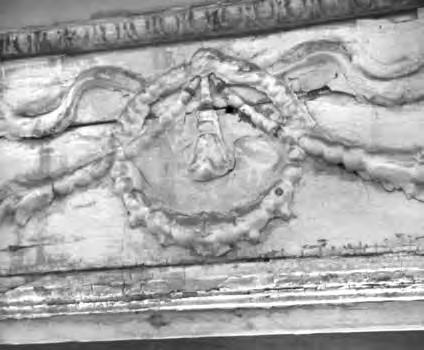
releading the windows. Then they placed each window in a mild acid solution for about three hours to clean off accumulated deposits of calcium, lime, and rust. This solution also loosened the glazing putty, making it easier to remove the old lead came and take the window apart. After thoroughly rinsing each window, they then soaked it overnight in a clear water bath. Next they carefully dismantled the window, removed the lead came, and reassembled the pieces on top of the reference rubbing.
When Elsie Rail began releading the windows, a process she likened to working on a jigsaw puzzle, she substituted an “H-round” lead, a came with a slightly wider channel than the original, in order to secure the edges of the textured glass within the lead. (The original leading left many of the textured glass edges exposed.) Artistic Designs also decided to install four new 3/8” diameter vertical reinforcing bars into each panel, carefully positioned to insure that none of the glass or jewels was obscured. The restored window was then mounted in its refurbished frame and returned to Berkeley for installation. Artistic Designs installed the last restored window just prior to Berkeley’s centennial celebration on October 18, 1998.15
The restoration of the engine room, by contrast, required considerably less delicacy but was demanding in quite different ways. Workers approached the engine room and its equipment with needle scalers, chipping hammers, scrapers, knives, picks, and occasionally solvent. Andy Anderson estimates that his crew removed several tons of paint and grease from the engine room.16
Smaller pieces of engine room machinery were dismantled, marked, and taken above for cleaning, “prepping,” and finishing. One of the final challenges in preparing the engine room itself for paint was in cleaning the steel “diamond deck” pattern underfoot, which occurred after Berkeley had opened to visitors. Since using chipping hammers and needle scalers indoors on metal created an incredible racket, the crew was forced to fit this project around visitor hours, so they scaled prior to opening every morning. Working on hands and knees, the crew used ice picks and toothbrushes with paint thinner to clean the tread. It required approximately six months for a crew of four, frequently assisted by volunteers, to prep the entire diamond deck. With the arduous task of preparation complete, painting went quickly.17
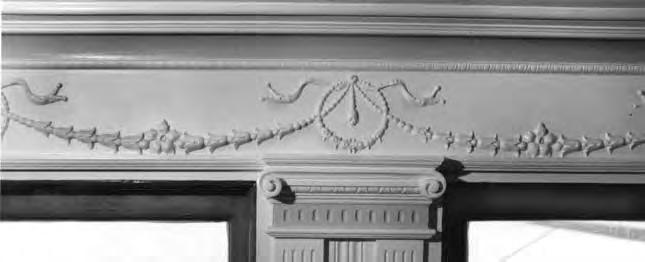
Museum trustee and retired Chief Engineer Ed Paxton and his engineering crew moved into the engine room after the painters finished, and began work on the mighty triple expansion engine. Intent on restoring the engine to working condition to demonstrate its operation to visitors, Paxton removed enough of the piston components to reduce the friction within the cylinders. The original plan had been to use the engine’s own jacking gear to turn it over; the jacking gear had enabled the ferry’s engineers to move its pistons into starting position by hand. Prolonged repetitive use of the jacking gear for this purpose, however, would have worn it out. Ultimately, Paxton’s ingenuity and hard work resulted in a moving triple-expansion engine powered by a hydraulic pump system.


After the engine room was restored, the painters began work on the boiler room. Once again they scaled off the old paint, prepped the area, and applied new primer and finish coats. As soon as they completed the job, Ed Paxton and his crew of volunteers moved in to restore the boilers and the fireboxes. With the addition of a forward access door cut into the watertight bulkhead and a number of labels, visitors had the opportunity to walk through the vessel’s impressive engine and boiler rooms for the first time.

While Berkeley had been well-built in 1898, her steel hull had never been intended to last for over a century. Until 1990, preservation work on the vessel’s structural steel elements had been limited to repairs made to bent and snapped steel sponsons on her starboard side. The sponsons, steel braces which run from both sides of her hull to undergird the overhanging wooden superstructure, were casualties of a dramatic winter storm in January 1988, when wind gusts up to sixty-four knots and storm tides had shoved her starboard side hard into the Embarcadero. Only quick thinking and action saved her from much greater damage.18


In late 1990, an inspection of the interior hull revealed substantial corrosion and the need for immediate action to keep the ferryboat afloat. Union Iron Works had given Berkeley a riveted steel shell of 3/8-inch-thick plates, with frames on twenty-four-inch centers. The only obvious hull repairs since her construction were some welded insert plates and doublers added to prolong her service life. The museum considered a variety of options to restore and preserve the weakening hull. The cost of a shell plate overlay or a resin-and-glass external coating proved prohibitively expensive. Such work would also have put the vessel in drydock for months, greatly reducing the museum’s ability to function. After consultation with Campbell Industries, San Diego Shipyard, and A. E. Yale Enterprises, and in-depth examination and consideration of alternatives, the museum decided to create a strong, water-resistant skin inside the hull. Workers first removed approximately six tons of rust and scale from the bilge spaces. A coat of “Rim 7” hard urethane was sprayed into the cleaned bilges, then a closed-cell urethane “grow foam” was applied, filling the space between each frame. After this was cured and smoothed, a top coat of “Rim 7” was sprayed on to form a continuous hard smooth surface.19 The project, which began in November 1990 and was completed the following July, required approximately 67,000 pounds of urethane foam. Shelves, racks, and lighting were installed in the completed spaces, making them far more useful for storage.

Museum staff, however, recognized that the inner coating offered only a short-term solution to the problem of an aging steel hull. On March 31, 2003, Berkeley was towed to drydock for the first time in thirty years, for the application of a high-tech ceramic coating to her hull exterior. Before she left, divers had already begun to scrape off a fantastic amount of accumulated marine growth. In drydock at Southwest Marine, six thousand more tons of barnacles and rust were carefully water-blasted off, which demanded up to 35,000 psi of pressure, easily enough to slice through her hull. When the hull finally emerged from beneath its cloak of marine growth, Museum Director Ray Ashley found that it was “peppered with more than 5,000 pits, some the size of dimes. In one spot, where blasting blew through a plate in the engine room, you could see the hull was paper-thin.”20 Once repairs were made, a team flew in from Texas to apply a state-of-the-art ceramic-loaded epoxy coating that had been developed for use in offshore oil fields. After her brief absence, Berkeley returned to her mooring on the Embarcadero on April 23, 2003.
Most of the work of preserving Berkeley, by contrast, is slow and never-ending. Time and the elements still work against the ferryboat, requiring strict vigilance, ongoing preservation, and, when needed, more restoration work. When the museum purchased Berkeley, the crew recognized the importance of the task they undertook and the level of commitment it demanded. Chuck Thomas, the paint crew supervisor since 1977, credited the 1973 museum staff with foresight, courage, and the wisdom to see the ferryboat as a historical treasure of national importance. Reflecting on the maintenance crew’s responsibility, he remarked that the task of restoring and preserving Berkeley, then and now, would be simplified if
we get rid of all this Victorian archaic stuff, do the whole side of the boat vinyl siding, get rid of the four-pane windows and put sliding aluminum windows in. We can “pasteurize” this thing to the point where we don’t have to do so much maintenance. But then if we do that, we’ve eliminated what our goal is—to preserve the vessel, not to make it affordable . . . We’re here to preserve it, to make it last as long as we can during our tour of duty and hopefully somebody will take the initiative the next tour of duty and put the amount of effort into it that we did.21
Well over a century after her launching, staff and volunteers continue to dedicate a great deal of time and effort to maintain, restore, and preserve Berkeley Undoubtedly many more await their own tours of duty, and the opportunity to see this extraordinary vessel through her next hundred years.
1 Andy Anderson, interview, 11 June 1998; MacMullen Library and Research Archives, Maritime Museum of San Diego (hereafter MMSD).
2 Chuck Thomas, interview, 17 September 1998, MMSD.
3 Anderson, interview.
4 Staff members applied the wood preservative cuprinol (copper naphthenate), to interior beams before attaching the new planking. Cuprinol is generally applied like paint and leaves a dark green coating on the wood’s surface. Since this coating bleeds through primer and finish, it was generally used only on interior structural wood. Once this surface coating is breached by a nail hole, a gouge, or a crack or check due to weathering, however, cuprinol’s ability to protect wood is compromised.
5 Anderson, interview.
6 Ibid. The product used was Z-Spar Brolite yacht enamel. During the restoration process, Museum personnel adhered to safety standards of the day that regulated the removal and disposal of the lead-based paint. The museum never applied leadbased paint to any surface on board the Berkeley or its other vessels.
7 Ibid. See also Thomas, interviews of 5 March and 17 September 1998.
8 Ibid.
9 Thomas, interview.
10 Berkeley’s plans are preserved at San Francisco Maritime National Historical Park, as HDC 345, Bethlehem Steel Coll.
11 Salvatore Bompensiero interview, September 18, 1998, MMSD.
12 The clerestory windows, though referred to as stained glass, are actually opalescent glass. Strictly speaking, stained glass is achieved by painting, or staining, and then baking transparent colors onto a glass surface. Opalescent glass, also known as “art glass” and “American glass,” is created by mixing colored metallic oxides into the molten glass before it is poured, rolled, and cooled. An American glass type, it is opaque with variegated colors in which light is held and refracted internally. The glass used in Berkeley did not require painting or staining. The California Art Glass Bending and Cutting Works, established 1879 and incorporated 1893, was located at 103-105 Mission St., San Francisco, in 1898. It last appears in city directories in 1916.
13 Quoted in Joe Porcelli,”The Berkeley Ferry Restoration,” Glass Craftsman 142 (June/July 1997): 18.
14 Kokomo could not match one of the reds used in 1898 due to Environmental Protection Agency restrictions concerning certain glassmaking procedures. Marie Tatina selected the Kokoma glass closest in color, painted the surface with a Fuse Master mahogany color, and refired the glass in a kiln.
15 Each window was glazed with a 10/12 DAP mixed with whiting and turpentine. This compound, an old glazer’s recipe, provided a malleable and resilient cement that filled any openings between came and glass, allowing the glass to expand and contract within the frames. Elsie Rail brushed the leading until achieving a rich black patina. A slight modification by carpenters to the window mounts was necessary, because they had been installed in a manner that made them impossible to remove without first removing all the surrounding millwork.
16 Anderson, interview.
17 After the engine room was stripped to bare metal, machine surfaces were masked and a coat of damp-proof red Rustoleum 729 primer applied. Next they applied a coat of 3/4 729 primer and 1/4 white primer, which permitted them to see which surfaces had been painted. Andy Anderson mixed enough lamp black into the third coat, a white undercoat, to distinguish it from the final white coat that followed. The paint crew then reinstalled all the small engine pieces that had been restored off-site, and completed all detail painting by hand. Ibid., and Thomas, interview.
18 Alan Thewlis, “The Story of the Berkeley,” Mains’l Haul 30 (Summer 1994): 8. Following the 1988 storm damage, extensive work on her sponsons took place at Campbell Shipyard.
19 Ken Franke, “Bilge Preservation in the Berkeley,” Mains’l Haul 27 (Summer 1991): 19.
20 Jack Innis and Terry Tilton, “S.O.S.! Texas Coatings Team Saves Sinking Maritime Museum Ship,” Coatings Pro (November 2003), 50-60. See also Full & By 13 (Spring and Summer 2003). The substance is known by the trade name CeRam-Kote.
21 Thomas, interview.




